They’ll help you navigate challenges, build relationships, and create a unique brand. Think of them like the essential ingredients in your baking pantry: they’re necessary for ensuring a perfect outcome.
Ready to discover these secret ingredients for success? Keep on reading to find out more!
Editor’s Note: This was originally published back in 2018. It has been updated today, June 17, 2024.
What are business virtues?
In the context of any business, virtues refer to the positive character traits, values, and ethical principles that guide decision-making and actions within a company. These virtues play a crucial role in running a successful food business.
Businesses that uphold strong virtues are more likely to earn trust, build lasting relationships, and achieve long-term success. Having these virtues fosters a positive company culture and attracts and as well as retains customers, leading to increased profitability and sustainable growth.
For example, imagine a home baker known for their delicious cupcakes. They consistently use fresh, high-quality ingredients, demonstrating integrity and a commitment to quality, plus they note dietary restrictions, showing respect for their customers. The baker also donates leftover cupcakes to a local shelter, demonstrating social responsibility.
These virtues, woven into every aspect of their business, cultivate a loyal customer base and contribute to their overall success.
The Eight Business Virtues For Your Food
Now, let’s delve deeper into eight specific virtues that are essential for achieving success in the food industry.
Integrity
Integrity is the foundation of a successful food business. It means being honest and truthful in everything you do, even when no one’s watching. In the food industry, trust and safety are super important, so integrity is a must.
How do you know if your business has integrity? Look for these signs:
- Customer trust: People believe in you and your food.
- Customer loyalty: They keep coming back for more and tell their friends.
- Long-term success: Your business keeps growing and doing well over time.
Think of integrity as a secret ingredient that makes your business delicious in more ways than one!
Accountability
Accountability means taking responsibility for your actions and decisions. In the food industry, this means owning up to mistakes and quickly correcting them. Like integrity, this virtue is essential for building customer trust, fostering a positive work environment, and ensuring compliance with food safety regulations.
Here’s how accountability benefits your food venture:
- Builds customer trust: Customers appreciate honesty and knowing you’ll fix any problems.
- Fosters teamwork: If you have employees, being accountable sets a good example for them to follow.
- Ensures compliance: You follow food safety rules to keep your customers safe and avoid legal trouble.
Transparency
Transparency is crucial for food businesses, as it involves being open and honest with customers about ingredients, processes, and practices. This leads to building trust in your brand and allows customers to buy from you, knowing that your products align with their preferences and values.
For example, if you have an online cookie business, you should list all ingredients to ensure food safety, provide accurate nutritional information, and help customers make informed choices.
Transparency leads to:
- Customer confidence: People feel good about what they’re buying.
- Better issue management: You can quickly address any problems.
- Competitive advantage: Your honesty sets you apart. Additionally, if you publicize that you’re using high-quality ingredients, you can attract customers seeking premium products!
Fairness
Fairness is a core value for any successful business. It involves treating everyone equally and with respect, whether they are customers, employees, or suppliers. This means charging fair prices, paying employees a just wage, and ensuring timely payments to suppliers.
For example, suggested retail prices (SRPs) help maintain consistent pricing across different stores, ensuring customers are treated fairly regardless of where they shop.
Fairness in your business practices leads to:
- Customer trust: Customers feel valued when they know they’re being charged fairly and treated equally.
- Better employee morale: Fair treatment and compensation boosts employee morale and loyalty, leading to a more productive team.
- Strong supplier relationships: Paying your suppliers on time and offering fair terms cultivates positive relationships, ensuring a reliable supply of quality ingredients.
Resilience
Resilience is essential in the ever-changing food industry. Challenges are inevitable, from unexpected ingredient shortages to shifting consumer trends.
A real-life example of resilience is how the restaurant industry adapted during the COVID-19 pandemic. Since dining in was not possible, they innovated with takeout and delivery services, outdoor dining, and virtual cooking classes.
How can resilience benefit your food business?
- Grace under pressure: When faced with setbacks, you find solutions and keep moving forward.
- Adaptability: No matter the food trends that come up or what preferences customers suddenly have, you can embrace change and adjust your strategies to stay competitive.
- Positive mindset: You maintain optimism and motivate your team, even during tough times.
Innovation
Innovation is the key to keeping your food business fresh and exciting. It means thinking of new ideas for your dishes, services, or marketing strategies to attract and retain customers.
For example, if you want to start a Filipino restaurant, you could develop a unique fusion menu blending traditional flavors with international cuisine or offer innovative online ordering options to enhance convenience.
How innovation drives success:
- Competitiveness: Unique dishes and approaches set you apart from the competition.
- Happy customers: New and improved offerings keep customers engaged and coming back for more.
- Business growth: Expanding your menu or services to cater to emerging trends can attract new customer segments and boost your bottom line. For instance, making keto desserts in response to customer demand could attract a new group of customers!
Remember, innovation is not just about being different; it’s about creating value for your customers and staying ahead of the curve.
Customer-centricity
Customer-centricity means putting your customers at the heart of your business. This approach prioritizes their needs and preferences, ensuring their satisfaction and loyalty.
For example, a successful Mediterranean restaurant might prioritize customer feedback to improve its menu, ensuring that dishes are consistently fresh and delicious.
Customer-centricity drives success through:
- Customer satisfaction: Prioritizing customer needs and preferences leads to happy customers, who are more likely to return and recommend your business to others.
- Customer loyalty: When customers feel heard and valued, they become loyal patrons, choosing your establishment over competitors.
- Valuable feedback: Actively seeking and responding to feedback, both positive and negative, allows you to continuously improve and meet evolving customer expectations.
Social Responsibility
Social responsibility means caring about your community and the environment, not just profits. It’s about giving back and making a positive impact. For instance, you can use sustainable ingredients, minimize waste, and support local farmers by buying from them instead of the groceries.
How social responsibility benefits your business:
- Community support: Giving back to the community through donations or sponsorships fosters goodwill and attracts customers who value social impact.
- Environmental impact: Reducing your environmental footprint through sustainable practices appeals to eco-conscious consumers and can enhance your brand reputation.
- Customer trust: As mentioned above, customers are more likely to trust and support businesses that align with their values, such as environmental consciousness and community engagement.
By prioritizing social responsibility, you contribute to a better world and build a loyal customer base that values your commitment to something greater than just profits.
Now, here’s something else you need to know: while having these business virtues is important for running a successful food business, they’re not the only ingredients for success. You also need practical knowledge and skills to navigate the unique challenges of the food industry. But hey, you don’t have to look far to learn how to grow a successful business.
The answer is right here inside The Bailiwick Academy.
Join The Bailiwick Academy’s Food Business Bootcamp!
The TBA Food Business Bootcamp is a 14-week program that will give you the correct foundation to build and sustain a food business.
Here’s a sneak peek of what you’ll get inside the boot camp:
- Entrepreneurial Mindset: Spot untapped opportunities and stay ahead of food industry trends.
- Soul Branding: Identify your superpowers and attributes that set you apart to form an unforgettable brand identity.
- Branding 101: Develop a distinctive brand voice and an attention-grabbing visual identity.
- Business Basics: Avoid pitfalls that make 90% of new food businesses fail within the first year.
- Menu Planning: Master crafting irresistible menu items that keep customers coming back.
- Human Resources: Develop employee contracts, handbooks, and policies that protect your business.
- Marketing and Sales: Ignite buzz by creating irresistible social media campaigns that compel customers to share your brand.
- Accounting: Learn proven food costing techniques to price your menu items for optimal profitability.
- Food Costing: Discover inventory management hacks that lower costs and wastes, and give you high profit margins.
- Legal Fundamentals: Safeguard your food business from legal catastrophes by discovering the permits, licenses, and registrations you cannot overlook.
- Employment Law: Draft contracts that attract top talent, incentivize peak performance, and shield your business from legal backlash.
- Business Planning: Mesmerize investors, lenders, and partners with a business plan presentation that has them begging to fund your food empire.
This program is a comprehensive guide to building a low-risk, low-maintenance, high-profit food business. If you’ve been dreaming of turning your passion for food into a thriving business, this boot camp might just be the thing to help you get truly started!
Click here to secure your slot, and finally make your food venture dreams a reality!
—
Keep coming back to The Bailiwick Academy blog for more kitchen tips, tricks, and much more!
]]>To help you out, we’ve put together a list of vegetables that are keto-friendly and those you should avoid. Let’s get to it, shall we?
What is the keto diet?
Here’s a quick reminder of what the keto diet is: it’s a popular weight-loss strategy that requires dieters to cut their carbohydrate or carb intake to no more than 50 grams per day. You do this so you get into a state of ketosis, a state where you will start burning fat for fuel. As a result of going low carb, you lose weight!
However, that’s not the only thing keto can do for you. Some research shows that keto can improve your heart health, lower your bad cholesterol level, and reduce your risk of developing heart disease. Going on keto diets is also a great way to help treat age-related neurological decline such as Alzheimer’s disease.
There are even ongoing studies that say keto can prevent and treat cancer. It is hypothesized that cancer cells feed off carbs and blood sugar to grow and multiply, and by lowering your carb intake, you’re starving cancer cells’ fuel, which may cause them to decrease in size and die.
Of course, while a low-carb diet seems to carry plenty of health benefits, please don’t take any of the information we put here as strict medical advice. For additional information, it is best to consult with a registered dietician or a doctor.
On to the main topic. The big question: can you eat vegetables on the keto diet?
The answer is yes. However, in our quest for healthy eating, we might automatically assume that since vegetables are green, natural, and aren’t sweet, all are okay to eat on the keto diet. But that’s not the case—and you’ll find out why in the next section.
Vegetables To Limit On The Keto Diet
Starting a keto diet means watching your carbs, and that includes the veggies you eat. Not all vegetables are low in carbs, so it’s important to know which ones to limit.
What vegetables are bad for the keto diet (or at least, not recommended)? Read on.
Carrots
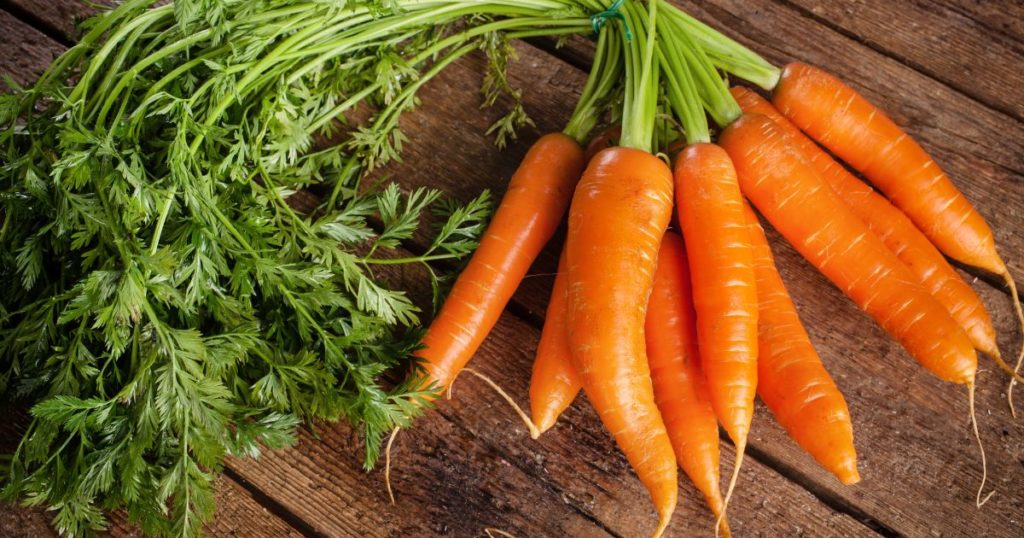
Carrot cakes (like the one in Chef Joey Prats’ class) are definitely not allowed, unless it’s a keto carrot cake like the one in Ms. Chiqui Ortiz-Dingcong’s class. But what about carrots themselves?
Well, bad news: carrots have more carbs than some other vegetables, with about 9 grams of carbs in each serving. If you’re on a keto diet and trying to keep your daily carbs under 50 grams, you’ll need to be careful about how many carrots you eat. It’s best to eat them in small amounts to stay within your carb limit.
Sweet Potato
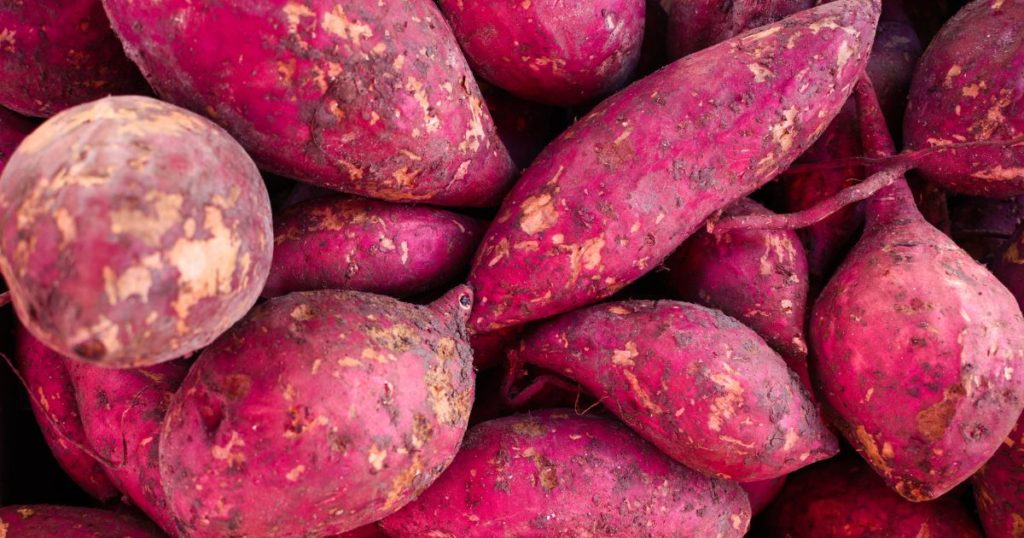
Sweet potatoes, including those turned into your favorite side dish like fries, are naturally high in carbohydrates. This (as well as other starchy vegetables) can pose a challenge for those on a keto diet, aiming for very low daily carb intake. Because of their carb content, sweet potatoes can make it harder to stay within the limits needed to maintain ketosis.
Legumes
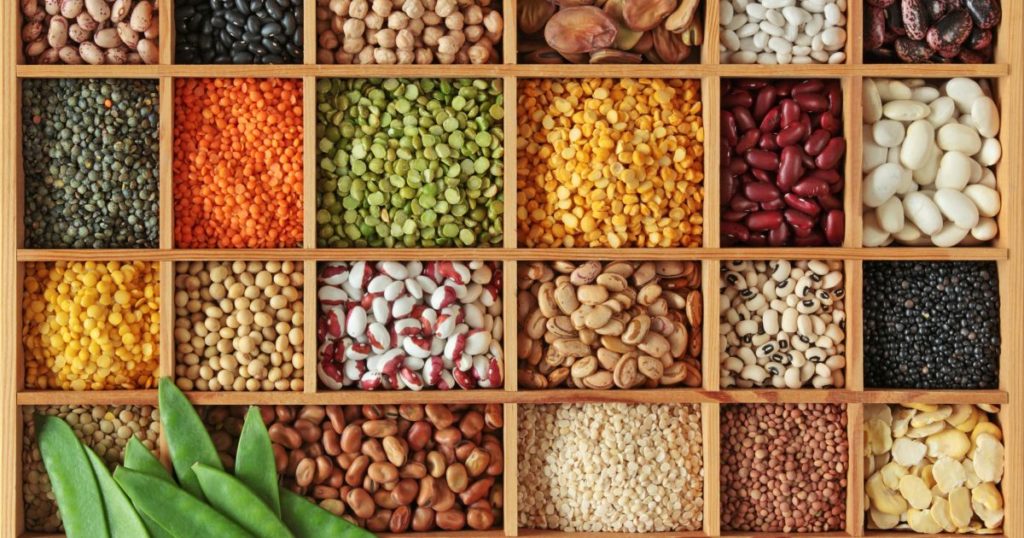
Legumes, including soybeans, peanuts, and lentils, are a popular protein source for vegans. However, these vegetables contain high carb content. This makes it difficult to stay within the low-carb limits required to maintain ketosis and achieve the full benefits of a keto diet.
Peas
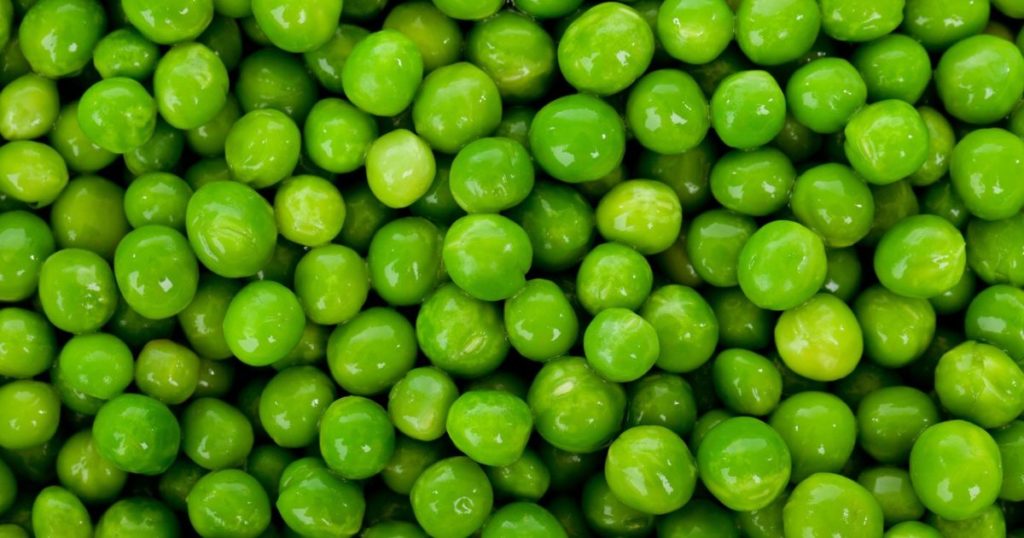
Don’t be misled by their small size—peas are high in starch, which means they’re also high in carbohydrates. Eating peas in large amounts can disrupt your meal planning and make it harder to stay within your daily carb limit. In short, it’s best to limit your intake of peas.
Onion
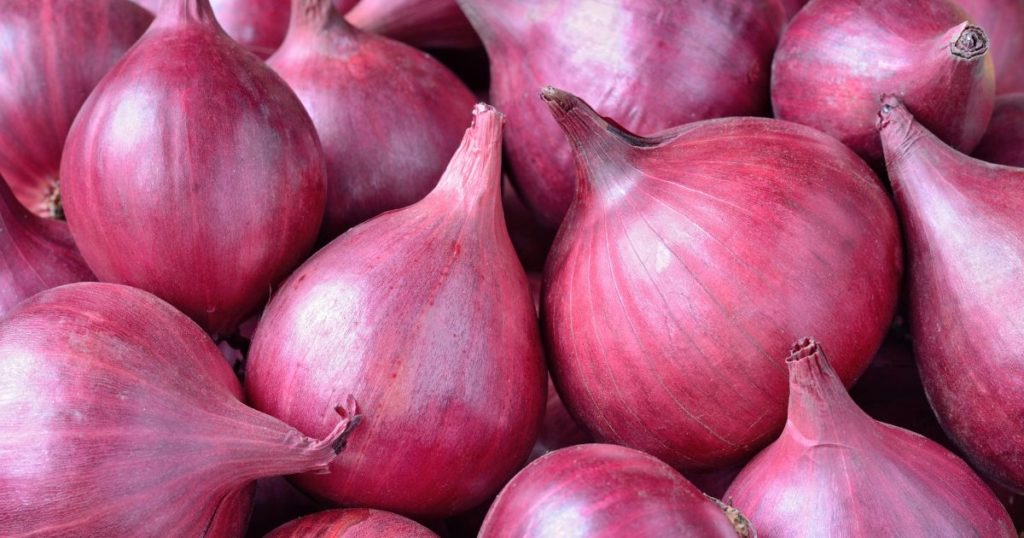
Don’t get us wrong: we at The Bailiwick Academy love onions. We even have a course all about onions! However, if you’re following a ketogenic diet, it’s important to use onions sparingly. Despite their delicious flavor and many uses, onions contain carbs that can add up quickly, making it necessary to moderate their use to stay within keto’s strict carb count.
Corn
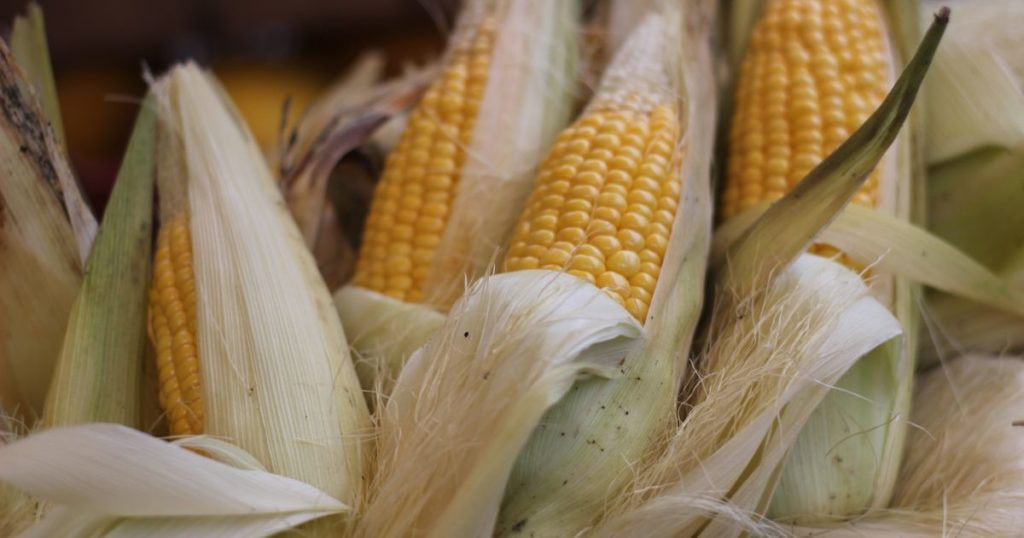
Corn is another food that might be tempting due to its sweet taste, but it’s not suitable for a ketogenic diet. It’s another vegetable high in carbohydrates, which can interfere with your efforts to maintain ketosis and achieve your weight and health goals. If you’re serious about sticking to keto, it’s best to limit or completely avoid corn.
Yam
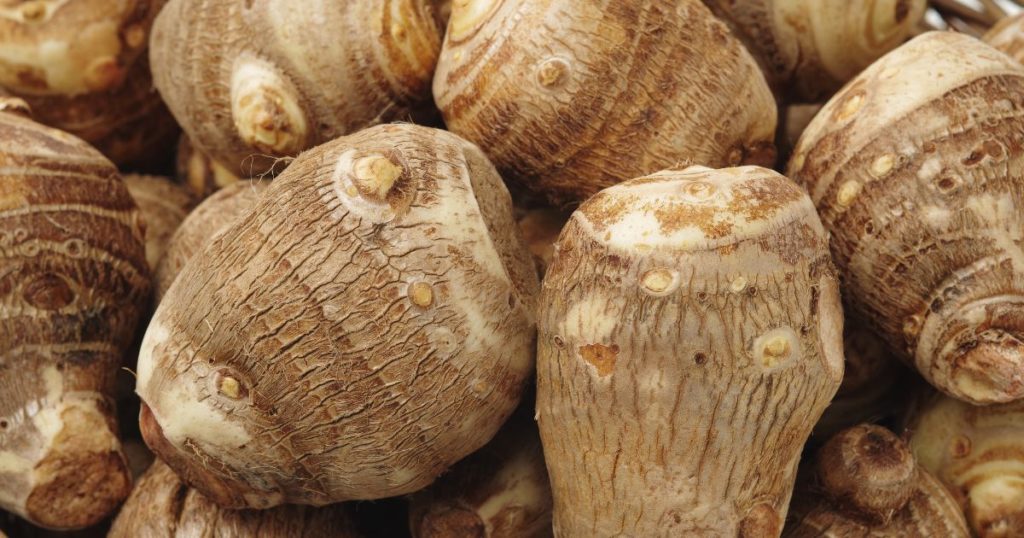
Yam is a root vegetable that packs a hefty carb count, ranging from 22 to 42 grams per serving. This is even higher than what you find in sweet potatoes. In other words, you’re not going to see yam in any type of keto meal plan.
Best Vegetables For The Keto Diet
This section is going to make you happy because it will show you which veggies are best for staying low in carbs but still getting plenty of nutrients.
Spinach
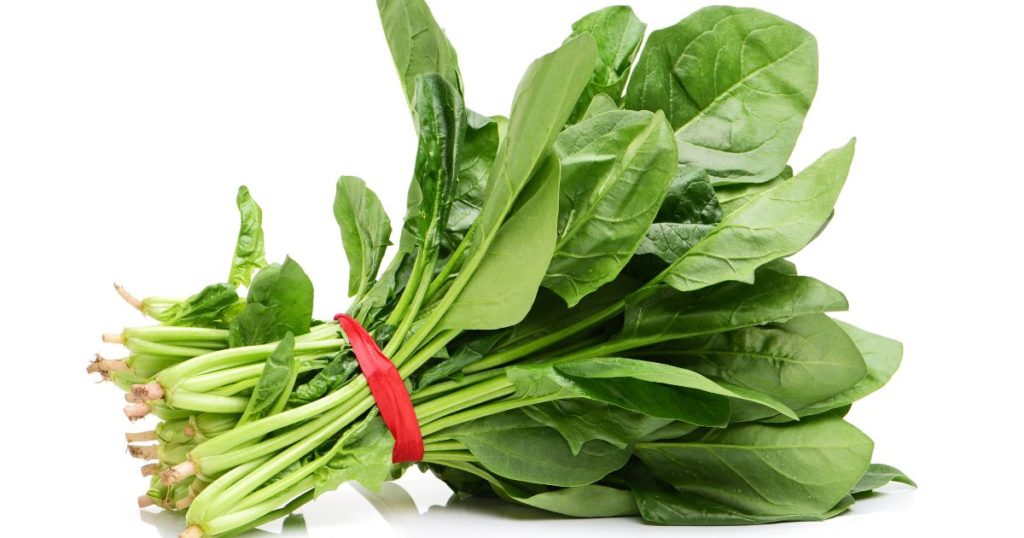
Spinach is a powerhouse of nutrients, rich in vitamins A and C, potassium, folic acid, iron, and calcium. Incorporating spinach into your diet can offer health benefits such as cancer prevention and reduced blood pressure. It’s not only beneficial for your overall well-being but also fits perfectly into a keto diet due to its low-carb content.
Bok Choy
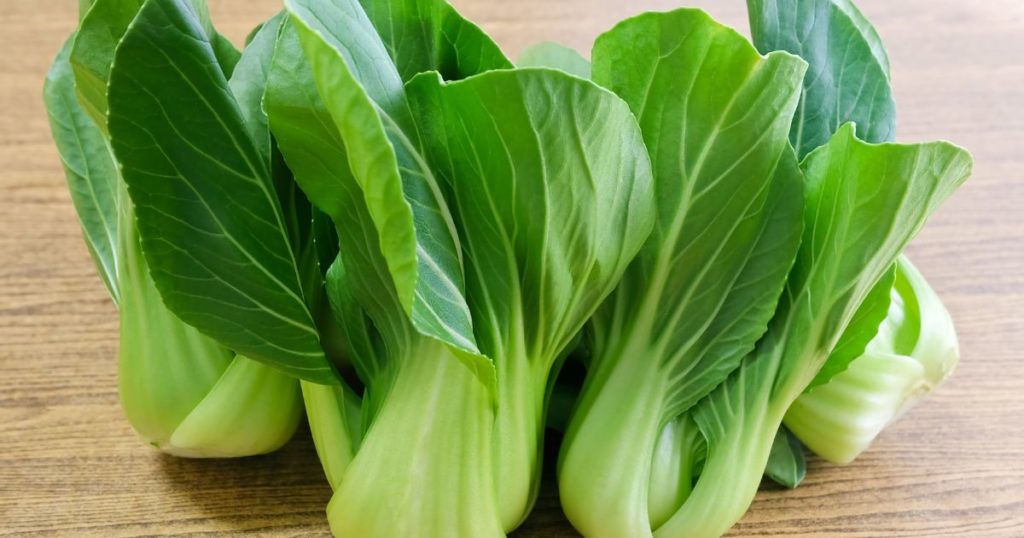
Bok choy is loaded with compounds that can help fight cancer, including vitamins C and E, beta-carotene, folate, and selenium. These nutrients not only contribute to its powerful antioxidant properties but also make bok choy a valuable addition to a keto diet, offering health benefits without adding many carbs.
Kale
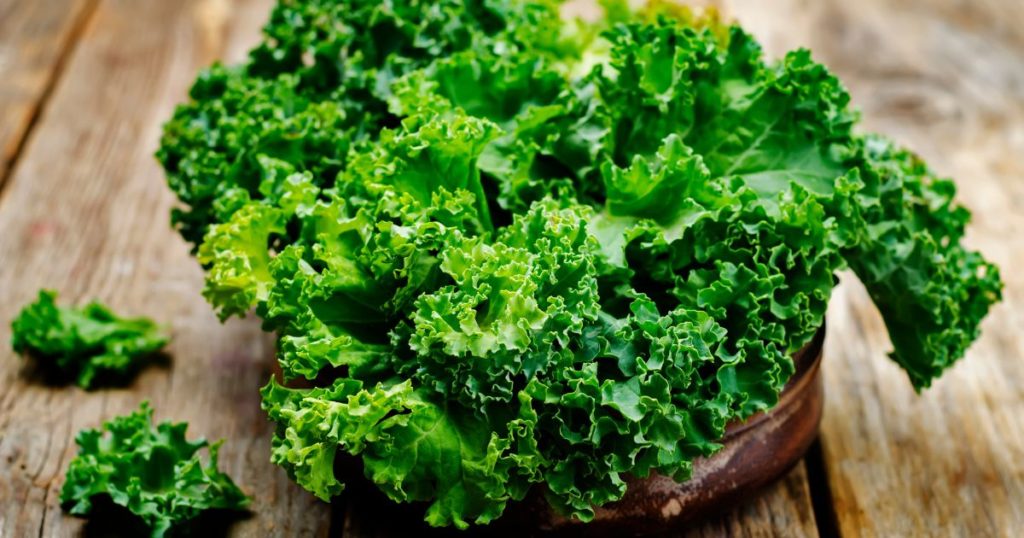
Kale is a nutrient-dense leafy green that’s low in carbs and high in beneficial nutrients. It’s packed with fiber, vitamins, minerals, and antioxidants that help prevent or slow cell damage. Regularly eating kale can lower your risk of type 2 diabetes, protect against heart disease, and promote healthier bones, skin, and hair. It’s an excellent vegetable for anyone on a keto diet, contributing to overall health without compromising carb limits.
Broccoli
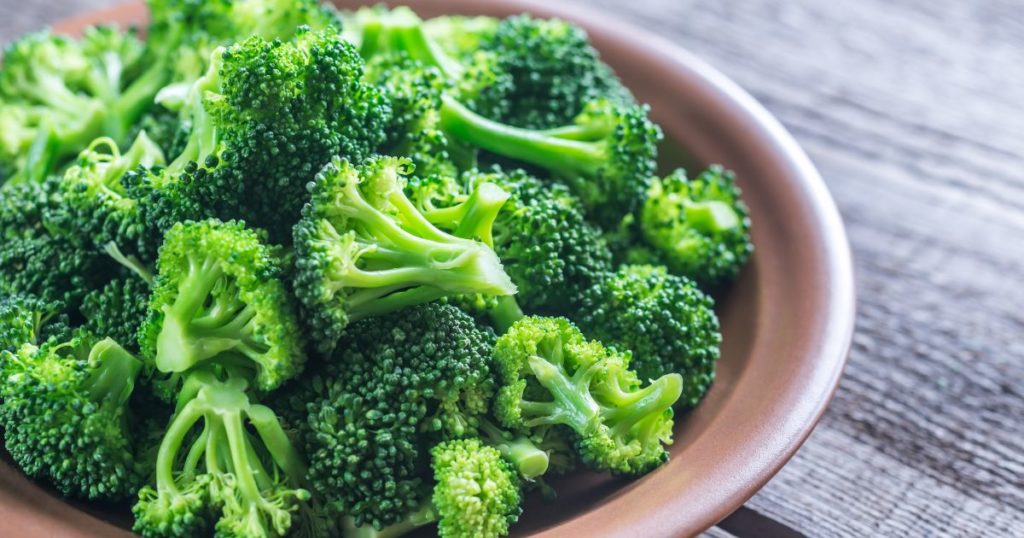
Broccoli is a versatile vegetable that can be enjoyed in various forms—raw, blanched, steamed, or roasted. It fits well in salads, side dishes, soups, pastas, and even as a rice substitute. Beyond its plenty of uses, broccoli is also a rich source of calcium, which is crucial for maintaining strong bones and preventing osteoporosis. This makes it a valuable addition to the keto diet, offering versatility and essential nutrients.
Cauliflower
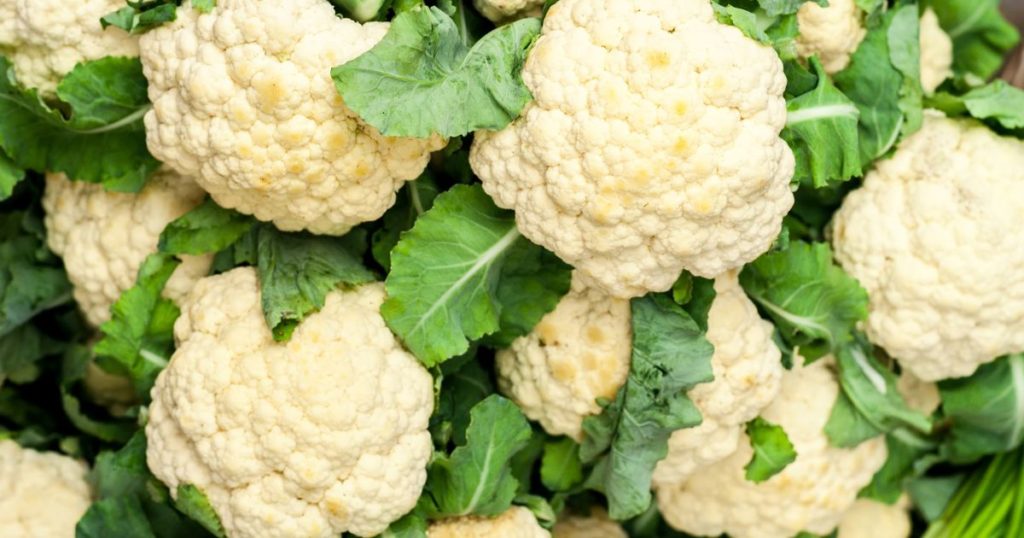
Cauliflower is a superfood that offers significant health benefits, including cancer prevention and improvements to gut and heart health. Its versatility is similar to broccoli, allowing it to be used as a rice substitute (yes, cauliflower rice is a thing!) or incorporated into various dishes. This makes cauliflower another excellent choice for those on a keto diet.
Asparagus
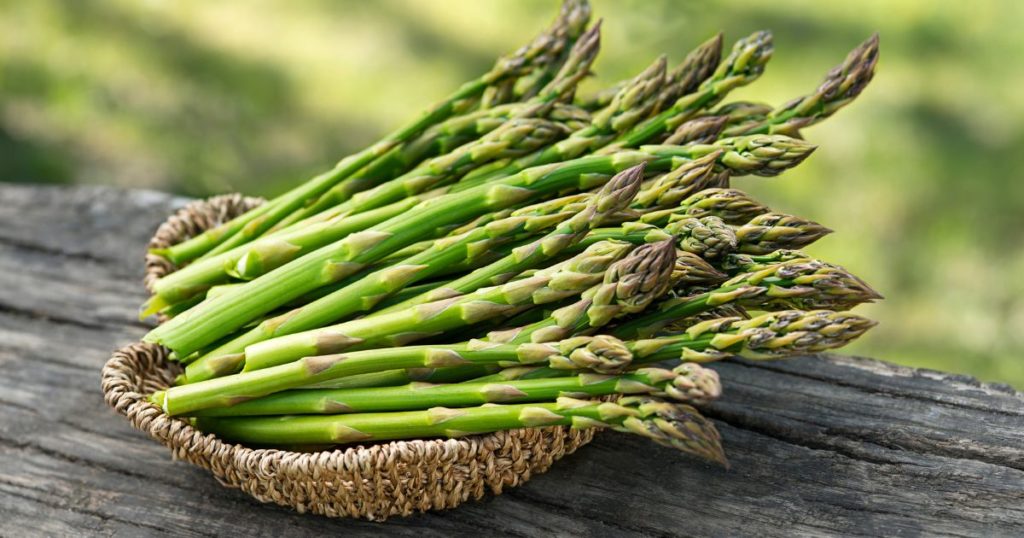
Asparagus might be known for its peculiar effect on the smell of urine, but its benefits far outweigh this minor quirk. It’s excellent for weight loss, helps prevent urinary tract infections, and can even boost your mood. And like all the others on this list, asparagus is a great choice for those on a keto diet.
Zucchini
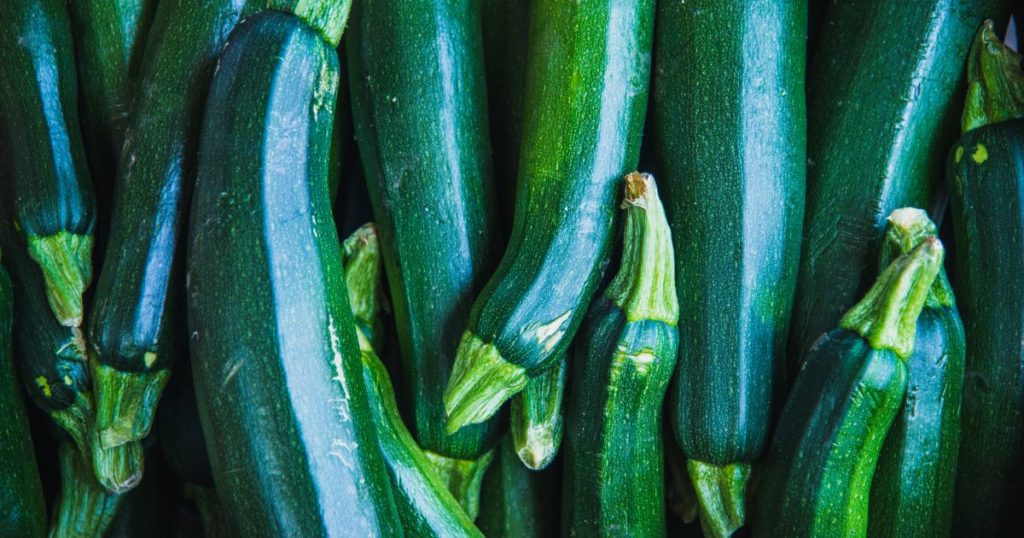
How To Ensure The Vegetables You Eat Are Keto-Diet Approved
Now you know what vegetables to eat and avoid while you’re on a keto diet. The next problem is this: what about vegetables that aren’t on this list? How can you find out which ones are, and which ones aren’t?
For instance, what if you’re eating outside? How can you make sure that what you’re eating is keto?
Well, if you really want to stick to a keto diet, it’s best that you be the one to prepare your food.
And if you want to add veggies to the usual keto food like meats, here’s a better way of preparing them: through the Keto Salad and Wraps class by Ms. Chiqui Ortiz-Dingcong!
If you’re health-conscious or eager to dive into the culinary world as an entrepreneur, this course is designed to introduce you to a range of mouthwatering, healthy dishes. Enroll now and master the art of preparing:
- Keto Tortilla
- Keto Mediterranean Salad with Chicken Souvlaki and Wrap
- Keto Mexican Salad with Beef Strips and Wrap
- Keto South Asian Prawn Salad and Wrap
And don’t worry; like all the courses at The Bailiwick Academy, this course is structured to be straightforward and accessible, making it ideal even for beginners. You’ll not only learn the basics of creating Keto Salads and Wraps but also acquire advanced culinary skills that will elevate your cooking.
Plus, this course will ensure that eating vegetables will never, ever be boring!
So what are you waiting for? Sign up now at The Bailiwick Academy! See you inside!
]]>From the deep, molasses-rich tones of dark brown sugar to the delicate, melt-in-your-mouth quality of powdered sugar, understanding these varieties can elevate your baking from the everyday to the extraordinary. Whether you’re crafting a tender pound cake, a batch of chewy sugar cookies, or a glossy meringue, knowing the right sugar to use can make all the difference.
Let’s explore these 11 types of sugar and how they can can make a world of difference in your baking.
Note: This was originally posted last February 24, 2021. This was updated on February 24, 2024.
11 Types Of Sugar #1: Granulated Sugar
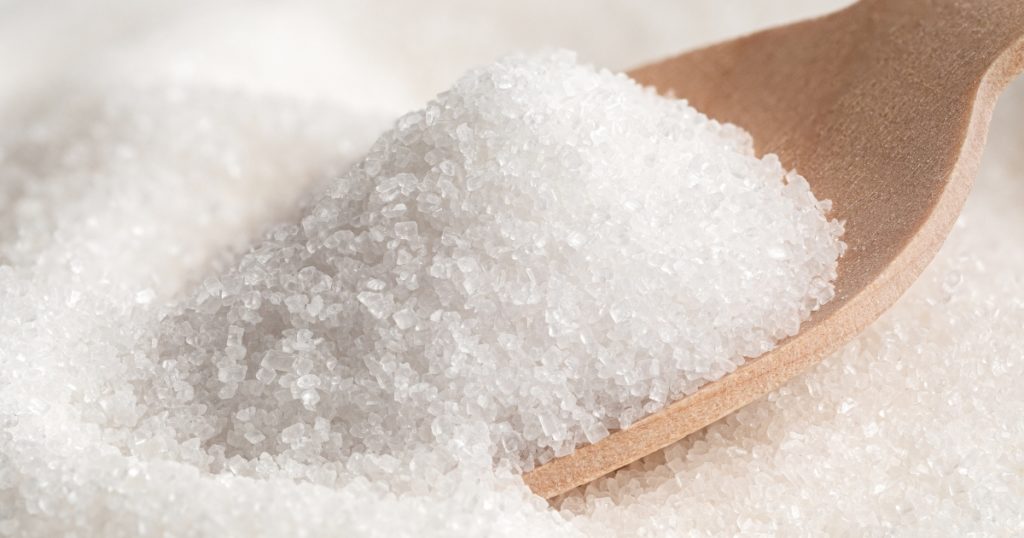
Granulated sugar, also known as table sugar or white sugar, is one of the common types of sugar. You make this from either sugarcane or sugar beets. You’ll also know this sugar by its fine, crystalline texture.
In baking, since it has a neutral taste, granulated sugar is a powerhouse ingredient, responsible for not just sweetening your favorite comfort food (i.e. pastries, cookes, cakes), but also contributing to their texture and structure. It aids in the creaming process, where you beat the sugar with fat (like butter) to incorporate air into the batter, resulting in a light and fluffy texture. Granulated sugar also helps in caramelization, giving baked goods a golden-brown crust and a subtle depth of flavor.
Mastering the use of granulated sugar can elevate your baking, making it a fundamental skill for any baker.
11 Types Of Sugar #2: Brown Sugar (Light And Dark)
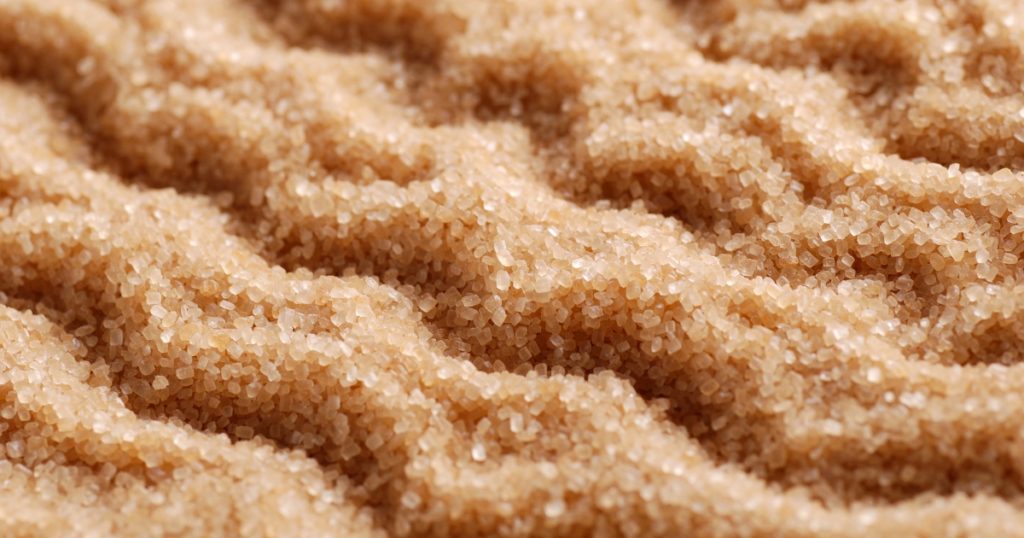
Light brown sugar, a staple in baking, offers a golden brown color and caramel flavor to baked goods. It contains about 3.5% molasses, adding moisture and chewiness that you don’t get from white sugar.
Dark brown sugar, on the other hand, with nearly twice the molasses content at around 6.5%, brings a deeper color and more robust flavor to recipes. This difference means using any brand of dark brown sugars instead of light can significantly affect the moisture, taste, and color of your baked goods, making them darker and more intensely flavored.
Oh and cool trivia: if you need it but you don’t have any, you don’t have to look for any substitute for brown sugar; you can just make your own! Just mix 1 cup of white sugar with 2 tablespoons of molasses for homemade light brown sugar. For dark brown sugar, simply increase the amount of molasses.
11 Types Of Sugar #3: Confectioner’s Sugar

Confectioner’s sugar, also known as powdered sugar or icing sugar, is finely ground regular white sugar and sifted to make a smooth powdery texture. Cornstarch is then added to the powdered sugar to prevent it from caking.
This fine sugar dissolves easily, making it ideal for frostings, icings, and ensuring a tender texture in baked goods. You can use this to dust, say, donuts and other sweets for visual and flavor appeal. It’s also perfect for sweetening whipped cream without the grittiness of granulated sugar.
Want to make your own at home? Just mix 1 cup of granulated sugar and blend it with one tablespoon of cornstarch in a food processor. Voila!
11 Types Of Sugar #4: Cane Sugar
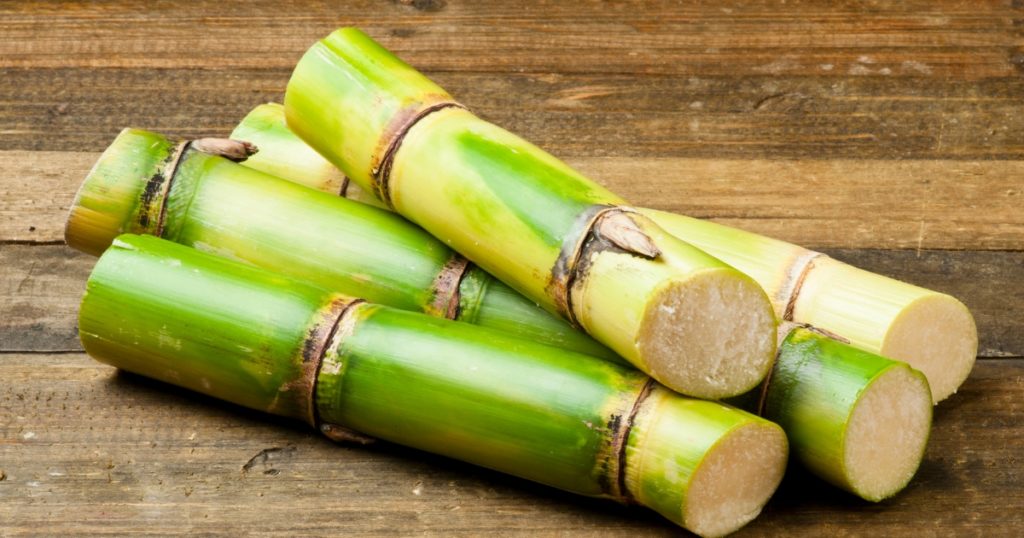
Cane sugar comes directly from the sugarcane plant and is less processed than granulated white sugar, retaining a bit of the natural molasses flavor and color. This sugar is known for its slightly larger crystals and a richer taste compared to standard white sugar.
In baking, cane sugar is a fantastic choice for bakers looking to add a hint of molasses flavor and a touch of richness to their creations without straying too far from the familiar results of white sugar. That’s especially true since it offers a subtle depth of flavor that enhances the overall taste of baked goods. It’s particularly good in recipes where a caramel-like sweetness is desired, such as in crumbles.
A note though: given its slightly larger crystal size, ensure it’s fully dissolved in mixtures to avoid a gritty texture, especially in beverages or fine pastries.Oh and one more cool note: Studies show that cane sugar contains high levels of polyphenols – potent antioxidants that can neutralize damaging free radicals in the body. Unlike regular white sugar, cane sugar also retains some vitamins and minerals from the sugarcane plant such as calcium, magnesium, and potassium. While moderate use is still advised, these nutrients give cane sugar a bit of an advantage over white sugars.
11 Types Of Sugar #5: Caster Sugar

Caster sugar is also known as superfine sugar. This sugar dissolves more quickly than regular granulated sugar, making it highly preferred for delicate baked goods like soufflés that need a certain mouthfeel. This type of sugar is also ideal for making meringues and cocktails, since it blends seamlessly into mixtures, ensuring little to no grittiness.
It’s a favorite for bakers who create exquisite desserts!
11 Types Of Sugar #6: Muscovado Sugar
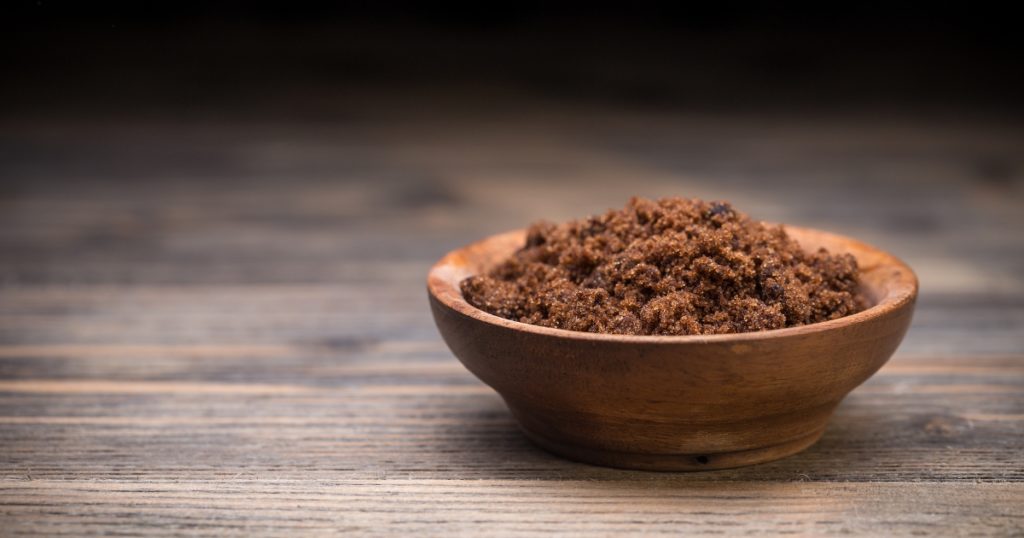
Muscovado sugar is a minimally processed sugar type. It’s a sugar with high molasses content, a rich complex flavor, and a moist sandy texture—it will remind you of butterscotch, actually. Its strong flavor is much more pronounced than that of traditional brown sugars, making it a distinctive choice for both sweet and savory dishes.
Muscovado sugar shines in recipes where its robust flavor can stand out, such as in molasses cookies, gingerbread, and rich chocolate cakes. It adds depth and complexity to desserts that benefit from its bold molasses notes.
Its rich taste is also a great addition to savory sauces and marinades, offering a balance of sweetness with a hint of bitterness. It can transform barbecue sauces, glazes, and even slow-cooked meat dishes.
And of course, it’s perfect for coffee!
11 Types Of Sugar #7: Raw Sugar (Turbinado And Demerara)
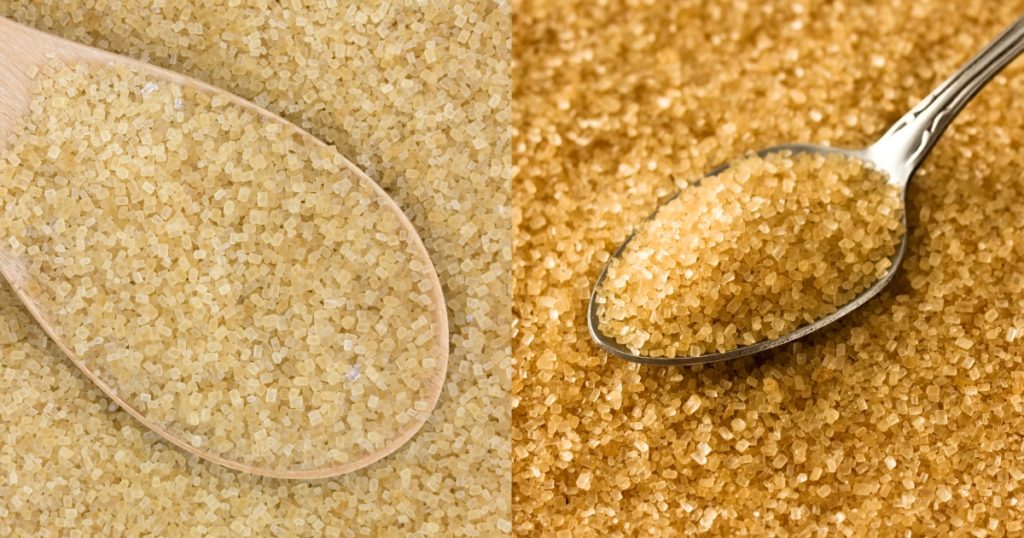
Raw sugars like Turbinado and Demerara are less processed than white refined sugars, retaining a natural golden-brown color and a slight molasses flavor. Turbinado sugar has large, sparkling crystals and a subtle caramel taste, while Demerara sugar has slightly larger crystals and a richer flavor profile. Raw sugars retain a light coating of molasses, unlike fully refined sugars that have the molasses completely stripped away. This gives raw sugars their distinctive color and taste.
Turbinado sugar’s larger crystal size and mild flavor make it ideal for topping muffins, cookies, and crumbles, adding a crunchy texture and a hint of sweetness. On the other hand, Demerara sugar’s richer flavor and crunchy texture work well in coffee, tea, and on top of baked goods. It’s also excellent for creating a caramelized crust on desserts like crème brûlée or sprinkled over fruit before baking.
11 Types Of Sugar #8: Liquid Sugar

Want liquid sugar? Just dissolve sugar in water and get a clear, sweet syrup. This form of sugar is ideal for beverages, such as coffee and tea, but it also has its place in baking and cooking.
Its main advantage in the kitchen is its ability to blend seamlessly into mixtures, eliminating the need for dissolution that granulated or powdered sugars require. This makes it particularly useful for moist cakes, sweet breads, and smooth sauces and glazes where a consistent sweetness is crucial.
11 Types Of Sugar #9: Sanding Sugar

Bakers often use sanding sugar’s large, coarse crystals that sparkle and shine to add a decorative touch to baked goods. Unlike finer sugars, sanding sugar retains its texture and appearance even after baking, providing a beautiful, glittery effect on the surface of cookies, cakes, and pastries. Its availability in various colors further enhances its appeal, allowing for creative and vibrant decorations that catch the eye—perfect for holiday treats!
For best results, sprinkle sanding sugar on top of cookies, scones, or muffins just before baking. This ensures the sugar adheres well to the surface and maximizes its sparkling effect. You should also brush your bakes with a light egg wash to make the crystals stick better and stay in place.
11 Types Of Sugar #10: Pearl Sugar

Pearl sugar, sometimes called nib sugar, consists of large, white, opaque granules that retain their shape and do not melt during baking. You use this kind primarily for decoration, adding a crunchy texture and a visually appealing finish to baked goods. It has a coarse hard texture and is opaque in color.
Pearl sugar is perfect for professional or home bakers looking to add a distinctive crunch and decorative flair to their baked creations. Mix it into doughs for items like Belgian waffles or sweet breads for pockets of sweetness. You can also use pearl sugar as a finishing touch on frosted cakes, rolls, and buns for added texture and visual appeal.
11 Types Of Sugar #11: Coconut Sugar

You get coconut sugar from the sap of the coconut palm tree. Among the variety of sugars, people know coconut sugar for its lower glycemic index compared to regular white sugar, making it a popular choice among those looking for healthier sugar alternatives. It also contains trace amounts of vitamins, minerals, and phytonutrients, adding a slight nutritional edge.
Flavor-wise, coconut sugar offers a subtle caramel-like taste, which can enrich the flavor profile of baked goods with a deep, warm sweetness.
Exploring the Sweet Possibilities: What’s Next?
Now that you’re familiar with these common sugars, it’s time to put this knowledge into action. Each type of sugar offers unique properties and flavors that can transform your baking and cooking, elevating simple recipes into something truly special. Here’s how to take the next steps in your culinary journey:
- Experiment with Substitutions: Start by substituting different sugars in your favorite recipes. Use coconut sugar instead of white sugar for a healthier option, or try muscovado in place of brown sugar for a deeper flavor. Remember, the key is to consider the moisture content and flavor profile of each sugar type.
- Adjust Recipes to Taste: As you experiment, adjust recipes based on the sweetness and flavor of the sugar you’re using. Some sugars are sweeter than others, so you may need to use less to achieve the desired taste. Additionally, the unique flavors of sugars like coconut or muscovado can add an unexpected twist to classic dishes.
- Focus on Texture and Color: Consider how the sugar affects the texture and color of your baked goods. For example, pearl sugar adds a delightful crunch to waffles and breads, while sanding sugar gives a sparkling finish to cookies and cakes.
- Creative Decorations and Finishes: Use sugars not just for their sweetness but as decorative elements. Experiment with colored sanding sugars for festive occasions or use powdered sugar for a delicate, snow-like dusting on desserts.
- Moderation is Key: As we discover new types of sweeteners for baking, we must also consider their impact on well-being. Consume sugar moderately. Striking a balance allows us to enjoy sweets without excess. We may even wish to explore sugar substitutions (i.e. the ones used for keto recipes) to support dietary needs. There are ways to craft delicious recipes while being mindful of our bodies.
Final Thoughts
Learning about the different common types of sugar is the first step to transforming your baking. Each sugar adds its own flavor and texture, letting you get creative in the kitchen. Whether trying healthier coconut sugar or experiencing the molasses taste of muscovado, the right sweetener can take your recipes from good to great.
I encourage you to experiment with these unique sugars in your baking projects. It’s not just about new tastes – it’s about making even better desserts. So grab an apron and see what sweet ideas you can whip up!
If you want to improve your skills more, The Bailiwick Academy offers fun baking and cake decorating classes. Sign up at The Bailiwick Academy today and try one of our courses now!
—
Keep coming back to The Bailiwick Academy blog for more cooking and baking tips, kitchen tricks, and much more!
]]>Well, here’s some good news for you: we have a list! We quickly dropped by a convenience store to see which chocolates are available to get you through those moments when you need a little indulgence without the fuss.
Let’s explore the range of delicious, convenient options waiting for you at your nearest store—at least, if you live in the Philippines. Get ready to rediscover some classic favorites and maybe even find a new go-to chocolate treat!
Best Chocolate You Can Buy: A Disclaimer
Before we dive into our chocolate extravaganza, a quick heads-up: This isn’t a comprehensive or authoritative list by any means. Think of it more as a curated selection of our favorite chocolate finds that are easily accessible and perfect for those spontaneous cravings.
So, what’s not on the list? For starters, you won’t find any white chocolate or gourmet chocolates here. We’re focusing on the timeless appeal of everyday brown chocolates. We also didn’t include any of the best chocolate you can buy online since this list is all about what you can quickly snag at your local convenience store — no waiting for delivery!
We’ve also left out the larger, more elaborate chocolate boxes. We aim to highlight those perfect grab-and-go treats that fit easily in your bag or pocket, ideal for that instant chocolate fix. And as much as we adore seeing an exotic truffle collection and the art of fine chocolate making, they’re not the focus of today’s list—we’re celebrating those every day, effortlessly obtainable chocolate bars.
Also, this list isn’t about which chocolate is the best—everyone likes different things. We’re just showing you the chocolates we found at the store.
Finally, we also didn’t include any pricing, since prices vary depending on where you buy your chocolate bar.
Got all that? Great. Now, on to the list!
Best Chocolate You Can Buy 1: Snickers

A satisfying mix of nougat, caramel, and peanuts, all generously coated in milk chocolate, Snickers bars are more than just a chocolate treat—they’re a filling snack. Snickers really fall under the best chocolate bar you can buy when you’re hungry, and you’re not yourself (cheers to those got this as Snickers’ tagline!).
You can easily get these at any convenience store or grocery store—perfect for those mid-afternoon hunger pangs!
Best Chocolate You Can Buy 2: Cadbury

Cadbury is really popular for its smooth, creamy chocolate. They have a variety, but not necessarily adventurous flavors, like fruit and nut infusions. A lot of people love it – Cadbury apparently sells over 350 million Dairy Milk bars every year!
Also, Cadbury was the first to make heart-shaped chocolate boxes and probably making chocolate synonymous with special occasions. Pretty cool, isn’t it? Of course, thankfully, you don’t need any special occasions to indulge in a Cadbury—they’re pretty accessible in groceries and various convenience stores.
Best Chocolate You Can Buy 3: Reese’s Pieces

Reese’s Pieces are a big hit among peanut butter lovers. People praise their chocolate coating, the peanut butter inside, and the fact that they don’t melt in your hands. If you’re into peanut butter, these tiny, colorful candies with creamy centers, crunchy shells, and delicious flavor and texture combinations are definitely worth a try.
Best Chocolate You Can Buy 4: Kinder Joy

Kinder Joy chocolates are really fun because of the surprise toy inside. It’s exciting to open the egg and see what toy you get. And with so many different toys, you’ll always find something new and surprising.
But let’s not forget the chocolate, with people marveling over its smooth and creamy chocolate paired with crunchy nougat. Whether it’s the surprise element or the creamy texture, Kinder chocolates are a delightful treat for all ages.
Want you and your kid to enjoy this? Give your kid the toy inside, and eat the chocolate. Rinse and repeat for each kid.
Best Chocolate You Can Buy 5: Hershey’s

Hershey’s chocolate bars are a big favorite in America—and worldwide, too! They’re simple and well-loved for their rich, slightly sweet milk chocolate. People like them—maybe because these chocolate candy bars remind us of simpler times or classic moments.
Best Chocolate You Can Buy 6: KitKat

KitKats is famous for its jingle and its perfect mix of crispy wafer and smooth chocolate. They’re great for sharing or enjoying on a break. People really like KitKats for their taste and the bright red, easy-to-carry packaging.
KitKats are also fun to eat. You can choose to eat the chocolate bar by bar or break them into pieces. They come in different sizes, too—you can get a pack with 2 bars, 4 bars, or even 8!
Best Chocolate You Can Buy 7: Toblerone

Toblerone has been a favorite chocolate for a long time, especially in the Philippines since the 90s. We’re sure we’re not the only ones who loved it when relatives brought Toblerone as a chocolate gift from abroad. It’s still also well-known as a chocolate that Filipinos love.
It’s not just tasty with its mix of honey and almond nougat but also looks cool with its unique triangle shape. You don’t have to wait for people abroad anymore to experience this; it’s practically sold everywhere!
Best Chocolate You Can Buy 8: Ferrero Rocher

For a more luxurious treat, Ferrero Rocher’s layers of wafer, hazelnut, and chocolate are unmatched. Each individually wrapped piece is a little sphere of heaven, making them great for gifts too!
Before, you couldn’t buy this just anywhere, but thankfully, Ferreros are now being sold even in convenience stores.
Best Chocolate You Can Buy 9: M&Ms

Here’s another brand that gives a fun element to the eater. M&Ms’ colorful chocolate coating makes each piece a treat to the eyes and makes it more appealing to eat. And, of course, it helps that they don’t melt in your hand, but they definitely melt deliciously in your mouth!
Each bag comes with a different number of colorful chocolate shells. You never know what you’ll get, which adds to the thrill of opening up a bag of hard candy with a satisfying crunch.
Best Chocolate You Can Buy 10: Mars

Are you a caramel lover but aren’t a fan of nuts? Well, Snickers are out, but Mars bars? Definitely in!
Some may find the Mars bar a bit too cloyingly sweet because of its soft nougat and caramel covered in rich chocolate, but the majority of people love the flavor combination. Bite into one when you need a burst of energy or just some sweet comfort.
For Those Who Are Chocolate Lovers, But…
You might look for delicious chocolates if you’re feeling down, but what if you have to be mindful about sugar intake or you have to guard your weight? Well, here are some ways to stay true to your health goals:
- Opt for Dark Chocolate: Dark chocolate is a great choice for those managing sugar intake. It typically contains less sugar than milk chocolate and is rich in cocoa, which is known for its health benefits.
- Portion Control: Enjoying chocolate in moderation is key. Opt for smaller portions or individually wrapped pieces so you can savor the taste without overindulging.
- Sugar-Free Options: Many brands offer sugar-free or low-sugar chocolate options. These products use sugar alternatives to provide sweetness, allowing you to enjoy chocolate without impacting your sugar levels.
- Focus on Quality, Not Quantity: Choose high-quality chocolate with pure ingredients. The richer the flavor, the less you may need to feel content.
- Balanced Diet: Incorporate your chocolate treat into a balanced diet. Pairing a piece of chocolate with healthy foods like fruits or nuts can balance your overall intake while still allowing you to enjoy your favorite treat.
Being health-conscious doesn’t mean giving up on chocolate. It’s all about making smarter choices.
Of course, it would help if you just had chocolates that were totally guilt-free, right? Well, it’s definitely possible!
Introducing the Keto Candy Bars Class by The Bailiwick Academy!
Check out our latest class with Ms. Chiqui Ortiz Dingcong: Keto Candy Bars!
You can create four kinds, each with a unique flavor:
Keto Chocolate Hazelnut Balls, a delicious combination of chocolate and crisp hazelnuts in perfectly portioned keto-friendly bites; Keto Peanut Butter Cups, where creamy peanut butter meets luscious sugar-free chocolate; Keto Chocolate Almond Bars, made with a blend of chocolate, roasted almonds, and coconut; and Keto Choco Caramel Candy Bars, boasting rich chocolate, velvety caramel, and a delectable crunchy shortbread cookie!
Not only will these be great to reach for when you’re looking to eat some chocolate, you can also add them to your food business menu—especially in time for the holidays!
What are you waiting for? Make some fine chocolate today that’s totally guilt-free! Sign up at The Bailiwick Academy today!
—
Keep coming back to The Bailiwick Academy blog for more baking and cooking tips, kitchen tricks, and much more!
Why make and give edible Christmas gifts?
Christmas food gifts are a thoughtful, inclusive, and delicious way to create lasting holiday memories and spread cheer. By investing time and care into baking or creating a culinary treat, you showcase your skills and creativity, making each gift a unique expression of affection. These gifts are delightful to receive, won’t contribute to clutter, and can be customized to suit individual tastes and dietary needs.
Convinced? Great! Now, if you’re wondering, “What can I make as Christmas gifts?”, well, we’ve got you!
On to the seven ideas!
Edible Christmas Gift Ideas To Make 1: Homemade Cookies

Homemade cookies are a timeless and delightful choice as one of your choices for Christmas gift ideas. You can make different flavors and styles that will suit everyone’s taste. It doesn’t have to be holiday-themed either, like gingerbread men or cookies shaped into candy canes—classic cookie shapes and flavors like chocolate chip cookies will do.
But if you want to keep with the season, pack them in decorative tins or cellophane bags tied with festive ribbons. And there, you have an easy, DIY gift of Christmas cookies!
Thinking of what cookies to make? Choose from these classes here at The Bailiwick Academy: Gourmet Cookies by Chef Bam Piencenaves, Best Ever Cookies by Chef Joey Prats, and Unique Cookie Concepts by Chef Miko Aspiras.
Edible Christmas Gift Ideas To Make 2: Polvoron In A Jar
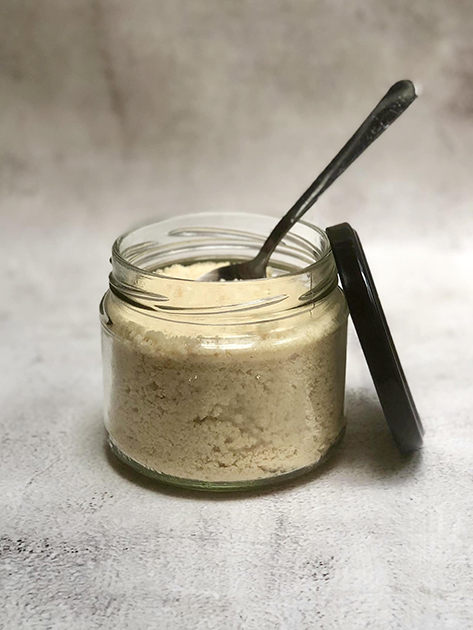
Polvoron traditionally is eaten molded into shapes, but why not give your loved ones something different? For this holiday season, surprise your loved ones with a creative twist on this classic delicacy by presenting the polvoron powder in mason jars. You can add a spoon so that they can eat out of the jar, but you can also attach instructions on how to mix and mold the polvoron, turning these edible gifts into a cute, delightful activity.
Looking for the best polvoron recipe possible? Check out Chef Miko Aspiras’ Madrid Fusiòn Polvoron class.
Edible Christmas Gift Ideas To Make 3: Cakes In Cans

Cakes in cans are a fun and unique edible gift idea for Christmas. Simply bake your favorite cake dessert recipes in a clean, empty can, and you’ve got a portable and delightful item great for Christmas gifting. You have the freedom to choose any cake recipe you like, from chocolate fudge to white chocolate to fruitcake.
Once baked and cooled, you can decorate the can with ribbons or stickers and add a little note to make it personal. This DIY gift is not only tasty but also shows your creative side.
Want to give these as gifts during the festive season? Check out Chef Joey Prats’ The Cake Cannery class or Ms. Chiqui Ortiz-Dingcong’s Keto Cheesecakes class for sugar-free, guilt-free options.
Edible Christmas Gift Ideas To Make 4: Pie

Homemade pie is a heartwarming gift that brings comfort and joy during the holiday season. Whether it’s a classic apple pie or every Pinoy’s favorite pasalubong, buko pie, it’s sure to be a hit. Bake it in a disposable pie tin, let it cool, and then wrap it up with some festive wrapping or place it in a pie box.
Add a little tag with a sweet message or the recipe, and your delicious, thoughtful food gifts are ready to go!
Looking for an easy recipe to make pies? Check out Chef Jimbo de Panadero’s Bakery-Style Buko Pie class or Chef Joey Prats’ Fabulous Pies class.
Edible Christmas Gift Ideas To Make 5: Savory Treats In Jars

Not everyone has a sweet tooth, and that’s where savory treats in jars come in handy. You can layer ingredients for a soup mix, create a homemade spice blend, or even jar up some chili oil, marinated olives or feta. These edible Christmas gifts in a jar are not only tasty but also show that you’ve put thought into catering to different tastes.
It’s definitely a great way to introduce friends and family to new flavors and recipes—and are great for business way after the holiday season.
To get more specific, you can:
- Enroll in Gourmet in a Bottle by Chef Chona Garcia-Laureta for some long-lasting, gourmet fish treats;
- Get Chef Allan Mertola’s recipe for Chili Garlic Sauce in his Dimsum 101 class, which we’ve heard are best-sellers for plenty of Bailiwickers; or
- Take Chef RV Manabat’s All-Natural Meat Processing class and learn his recipe for preservative-free Garlic Atsara, which, as we all know, is enjoyed by many Pinoys!
Edible Christmas Gift Ideas To Make 6: Christmas Ham

A Christmas ham is already a popular Christmas gift idea here in the Philippines, so why not make your own for a really perfect gift? You can be sure that receivers will appreciate this homemade edible gift, especially during family dinners for the holiday season.
And if you want to make some of the best hams ever, enroll in Sir Rodney Martinez’ Delicious Glazed Hams class. Make two kinds of hams and glazes that will take your loved ones’ ham experience to the next level!
Edible Christmas Gift Ideas To Make 7: Chocolate Truffles

Chocolate truffles are luxurious and decadent homemade Christmas gifts, perfect for those who appreciate the finer things in life. You can make them at home using good quality chocolate, cream, and a bit of butter, then roll them in cocoa powder, chopped nuts, or coconut flakes. Place them in a small box or cellophane bag tied with a ribbon, and you have an elegant gift ready to go.
And believe us, when you give these as gifts for friends, they will love you for life! After all, chocolate truffles are not just a gift; they’re an experience, rich and full of flavor. When you taste your creation, this homemade gift might not make it to your loved ones—they’re that good!
Speaking Of Chocolate Truffles…
If you’re on the hunt for a treat that’s both easy to make and irresistibly delicious, you’ve hit the jackpot! Check out Chef Chona Garcia Laureta’s class: Chocolate Cookie Truffles!
Enroll in this class and get an easy recipe for no-bake Chocolate Cookie Truffles! Imagine biting into a glossy chocolate shell and finding a velvety, melt-in-your-mouth center – that’s exactly what these truffles offer. They’ll strike the perfect balance between simplicity and indulgence, and are suitable for any occasion, making them a versatile gift option, not just during the holidays.
Ready to dive in? Sign up at The Bailiwick Academy today to start making these homemade food gifts! They’re simple but decadently delicious treats that are sure to impress!
Final Thoughts
We hope you found one you want to try from this list of edible Christmas gift ideas to make! This holiday season, let your loved ones know just how much you care with thoughtful, homemade gifts. From sweet to savory, there’s a delightful option for everyone.
Get creative, personalize your gifts, and embrace the joy of giving. Happy holidays!
—
Keep coming back to The Bailiwick Academy blog for more baking and cooking tips, kitchen tricks, and much more!
]]>Well, this Filipino shortbread is definitely a treat, something that has been captivating the taste buds of generations of Filipinos for a long time already. And in this article, we’ll talk about where it comes from, what’s in it, and why people love it.
Let’s dive in!
What is a polvoron?
So, first things first. Polvoron, often referred to as “polvorones” in Spanish, is a traditional Filipino shortbread cookie that is renowned for its crumbly and melt-in-your-mouth texture. It is a sweet, powdery confection characterized by its oval or round shape, depending on the polvoron molds used. The polvoron or shortbread cookies are usually presented in colorful cellophane or Japanese paper—the colors add to the fun of eating one.
The Filipino’s polvoron can also be eaten as a dessert or snack powder from jars. The toasted flour and/or powdered milk sugar make for an attractive treat, especially for children.
What is polvoron in English, and its origin?
“Polvoron” derives from the Spanish word “polvo,” which means powder. This highlights its powdery consistency. While it is similar to a type of Spanish shortbread also called “polvorón,” the Filipino version has unique characteristics and preparation methods since it was adapted to suit local tastes. It’s now as Filipino as banana ketchup or chicken adobo!
What is Filipino polvoron made of?
The primary ingredients of this Filipino food include:
- Toasted flour: Toasting flour provides the polvoron with its crumbly texture. This flour is carefully toasted for the polvoron’s distinct flavor and aroma.
- Powdered milk: Powdered milk is a must in any polvoron recipe. It adds a creamy and milky flavor and is one of the key elements that set it apart from traditional shortbread cookies.
- Sugar: Polvoron’s sweetness comes from sugar, which is blended with the other ingredients to create a balanced taste. It can be granulated sugar, milk sugar, or any kind of powdered sugar. Do take note that the choice of sugar affects the color of your end result.
- Butter or margarine: Butter or margarine is the binding agent for this Filipino shortbread cookie, holding the ingredients together and giving polvoron its melt-in-your-mouth quality.
- Toasted rice: This is an optional ingredient. Some add this to add a crunch and additional texture and flavor to polvoron.
Why is polvoron so popular among Filipinos?
For Filipinos, polvoron isn’t just a treat; it’s a piece of nostalgia. Many Filipinos recall childhood memories of making these with their grandparents or receiving these sweet treats during school events, fiestas, or from relatives returning from trips. Given its compact nature and colorful wrapping, polvoron is also a favorite pasalubong (gift/souvenir) for Filipinos to give when they visit friends or relatives.
What is the best powdered milk for polvoron?
While various brands can be used, it’s recommended to use high-quality, full-fat powdered milk to achieve the best taste and consistency.
Can polvoron expire?
You might assume that polvoron doesn’t expire because of its dry texture. However, like any other food product, polvoron can expire. That’s especially true since it has dairy content from powdered milk and butter.
Always check the expiration date if store-bought. If you’ve made homemade polvoron, consume it within 1-2 weeks for the best taste and freshness. The best way to store polvoron and keep it fresh is to store it in an airtight container in a cool, dry place, or refrigerated for a longer shelf life.
Can polvoron make you fat?
Polvoron contains sugar, butter, and milk – all of which have calories. Plus, it’s a sweet treat and is definitely not a keto dessert food. This means that, yes, regularly consuming them in large amounts without burning off the calories can lead to weight gain.
Can polvoron have flavors?
Yes, you can make polvoron that has different flavors. One popular variant is the ube polvoron, which incorporates the flavor of ube or purple yam. This gives the treat a distinctive purple hue and adds a unique taste to the candy.
Other flavors can be white chocolate, peanut, mango, matcha, cookies and cream and pretty much whatever else you can think of!
How do you make polvoron?
There are plenty of polvoron recipes you can follow, but here are the basic steps:
- In a pan, toast the flour over low heat until it turns golden brown. Let it cool.
- If you want to add toasted rice, get a separate pan, then toast the rice until it’s crispy and fragrant. Allow it to cool, then crush it into small bits.
- In a mixing bowl, combine the toasted flour, milk, sugar, and butter, and crushed toasted rice. Melt the butter and add it to the dry mixture. Mix well until the ingredients are fully incorporated.
- Using polvoron molds or your hands, shape the mixture into your desired shapes, whether round, oval, or whatever shape of mold you have.
- Let the polvoron set in the refrigerator for about 30 minutes.
- When done, you can serve as is, or wrap them in colorful cellophane or paper.
Now you have your homemade polvoron to enjoy or share with friends and family!
Want to make better polvoron at home?
Making polvoron is straightforward, allowing many to enjoy its taste. But wouldn’t you want to craft a polvoron that’s not only delicious but also world-class?
If the answer is yes, then we have some good news for you! Check out Chef Miko Aspiras’ latest course here at The Bailiwick Academy: Madrid Fusiòn Polvoron!
Chef Miko originally showcased his artisanal polvoron creations at the prestigious Madrid Fusión, a globally renowned culinary event that gathers top culinary talents and food enthusiasts from around the world. They were received with acclaim—and now, he’s sharing his recipes with us!
The Milky Cashew Polvoron has a buttery richness of roasted cashews that melds harmoniously with the velvety smoothness of pure milk. Meanwhile, the Strawberry Goat Cheese Polvoron offers a delightful contrast, uniting the subtle tang and sweetness of strawberries with creamy goat cheese. For an exotic twist, the Ube Coconut Polvoron combines the vibrant Ube with the tropical charm of coconut.
And last but definitely not the least, the Maiz con Kasuy Polvoron pays homage to cherished nostalgia, reimagining the classic corn and cashew combination with a modern touch, creating a delectable symphony of sweet and nutty flavors.
These polvorons are perfect not just for eating at home; they’re great for gifting, for catering menus, and food businesses!
So what are you waiting for? Sign up at The Bailiwick Academy today and start making artisanal polvoron now!
Final Thoughts
Polvoron is a sweet treat that many Filipinos love. It brings back memories for some and introduces a new taste for others. From its simple ingredients to the fancy versions made by chefs, it shows how a simple snack can become something special.
If you haven’t tried polvoron yet, it’s guaranteed that you’re in for a treat. And if you already love it, there’s always a new flavor to try. So, whether you’re making it at home or tasting a chef’s version, enjoy every bite of this Filipino favorite!
—
Keep coming back to The Bailiwick Academy blog for more baking and cooking tips, kitchen tricks, and much more!
]]>What is a keto cookie?
A keto cookie is an ingenious creation, to say the least! This keto food combines the joy of cookies and the principles of the ketogenic diet. Not only do they taste like normal cookies, but they also have low net carbs and are high in healthy fats.
That makes these the perfect indulgence while achieving or staying in a state of ketosis, where your body uses fats instead of carbs for energy.
The Ingredients Of Keto Cookies
What makes a cookie keto? Well, you’d have to use low-carb and high-fat ingredients. Here are some examples of what you’ll frequently use for the dough (not batter!) you’ll be laying out on your baking sheet:
- Almond flour: Almond flour has a low-carb and high-fat base. It’s one of the most frequently used flour not just for keto cookies but also for other keto dessert recipes such as a keto cheesecake.
- Coconut flour: Coconut flour gives you both a low carbohydrate count and a touch of coconut flavor.
- Sugar substitutes: You won’t be using any brown sugar or any other kind of powdered sugar in these kinds of cookies. But don’t worry—keto cookies will still be sweet thanks to the use of natural sweeteners like erythritol, stevia, or monk fruit sweetener.
- Healthy fats: Examples are butter (not margarine!), coconut oil, and nut butters (like almond butter). They’re the ones that give cookies delicious flavors aside from satiating fats.
- Eggs: Essential for structure and texture, eggs also give protein and more healthy fats to your cookie dough.
Other ingredients will depend on the flavor you’re going for. If, for instance, you’re making keto pumpkin cookies, then you’ll definitely have to use pumpkin puree and cream cheese.
Are these low-carb cookies healthy?
We’re not doctors, so we can’t really say that something is healthy per se, but keto cookies do come with some nutritional perks, such as:
- They’re low in carbs: Traditional cookie recipes are often high in carbohydrates and sugar, which is not good for you if you’re watching your blood sugar. With their low carb content, keto cookies are more suitable for diabetics and carb-conscious individuals.
- They help in weight management: Because these low carb cookies are high in fat and also contain plenty of protein, eating them will make you feel full faster. And that has a good effect of making you eat less since you still feel satisfied.
- You’ll have more energy: According to MSD Manuals, fats are the slowest source of energy but they are also the most energy-efficient. You’ll also get twice the energy compared to proteins or carbs.
Note that keto cookies aren’t the only source; you can more or less expect the same thing from other keto snacks or keto-friendly food such as keto bread.
What are the usual flavors of cookies that are keto-friendly?
Do you know what’s great about keto cookie recipes? Surprisingly, you’re not that limited in flavors. For example, you can make the following flavors:
- Choco-Nut Delight: Infused with sugar-free chocolate chips and chopped nuts, this flavor combination strikes a perfect balance between indulgence and nutrition. Think of this as a more flavorful, low-carb chocolate chip cookie!
- Zesty Lemon Burst: Want lemon cookies? It’s possible! The zingy essence of lemon zest combined with almond flour creates a refreshing and delicious cookie.
- Cinnamon Spice: A dash of cinnamon transforms keto cookies into a cozy, freshly baked treat.
- Decadent Dark Chocolate: This flavor is for true chocolate enthusiasts. You’ll get a rich and intense cocoa experience—without the guilt!
- Berry Bliss: Incorporating dried or freeze-dried berries into the cookie dough gives you a burst of fruity goodness with every bite. Just make sure the fruits are considered keto, such as avocado or strawberry.
- Peanut Butter: Yes, peanut butter keto cookies are also possible. You get the rich and creamy flavor of peanut butter but with keto-friendly ingredients. They’re satisfying, health-conscious alternatives to traditional cookies.
- Oatmeal: Substitute oats for keto-friendly ingredients and put them in cookies. You won’t have to lose the classic and comforting taste of oatmeal cookies!
Bake Your Own Keto Cookies: Enroll in The Bailiwick Academy!
Want to try and make surefire delicious keto cookie dessert recipes in the comfort of your home? You can—thanks to Ms. Chiqui Dingcong’s Keto Cookie Master Class!
With this class, you’ll be able to make 5-star keto cookies in four different flavors:
- The rich and moist Keto Red Velvet Cookies
- The delectable crunchy but soft and chewy Keto New York-Style Chocolate Chip Cookies
- The intricate Chocolate Hazelnut Thumbprint Cookies; and
- Indulgent Caramel Bourbon Cookies
It’s guaranteed that each cookie recipe will delight those who try it! And with recipe videos that give you comprehensive, step-by-step instructions and insightful tips, you’ll naturally evolve into an accomplished cookie maestro. Plus, you’ll be able to conquer the market for those looking for guilt-free treats!
Don’t delay—sign up at The Bailiwick Academy now!
FAQs
Q: Can keto cookies satisfy my sweet tooth?
A: Keto cookies can take getting used to. But when you get used to them, they will provide the sweetness you crave without derailing your low-carb journey.
Q: Are keto cookies okay for gluten-sensitive individuals?
A: The use of almond and coconut flours in keto cookies eliminates gluten, making them a good option for those with gluten sensitivities. However, it is still best to consult with your doctor before you push through with keto cookies as your go-to snack.
Q: Can I find keto cookies in stores or online?
A: Yes. Many health food stores and online platforms offer a variety of premade keto cookies. However, if you are particular about taste, it might be better if you make your own, such as enrolling in The Bailiwick Academy’s Keto Cookie Master Class.
Q: Do I need to follow the keto diet to enjoy these cookies?
A: No. While keto cookies are tailored for the ketogenic diet, they can be enjoyed by anyone seeking a low-carb, guilt-free treat.
Q: How do keto cookies compare to traditional cookies taste-wise?
A: Keto cookies might have a slightly different texture due to the alternative ingredients used, but their taste can be just as satisfying as traditional cookies.
Q: Can I bake keto cookies in my own kitchen?
A: Absolutely! Baking your own keto cookies at home allows you to experiment with flavors and ingredients to suit your preferences. But for a good base, enroll in TBA’s Keto Cookie Master Class.
Conclusion
Keto cookies beautifully blend taste and health and can be available in many flavors. Understanding their ingredients and benefits allows you to enjoy these treats as part of a keto lifestyle or simply as a healthier cookie option. With their delicious taste and health benefits, they are a great addition to any diet.
And again, if you want to make your own keto cookies, consider enrolling in The Bailiwick Academy’s Keto Cookie Master Class! It’s a choice you won’t regret—that’s a guarantee!
—
Keep coming back to The Bailiwick Academy blog for more kitchen tips, tricks, and much more!
]]>That means to achieve a successful bake, you’re going to have to follow the recipe to a T (it’s one of the basic rules of baking!). And for you to do that, you need to understand certain baking terms.
Feeling scared yet? Not to worry; that’s what this guide is for! Keep reading so you can say goodbye to confusing terms and hello to yummy outcomes!
Common Baking Terms – A
- Aerate: The act of incorporating air into your ingredients baking during the production process to increase volume. An example is the act of sifting flour.
- Aged egg whites: This is the process of separating egg whites from the egg yolks. You’ll then store the whites in a loosely covered container for 1-2 days. This process is normally used for baking French macarons.
- Autolyse: This is the process of mixing flour and water and allowing it to rest. This will help gluten development and makes dough easier to handle.
Common Baking Terms – B
- Bain-marie: A method of cooking delicate items such as custards that involves giving them a hot water bath. This is done to cook the items indirectly.
- Bake: To cook food by surrounding it with dry heat in an oven.
- Beat: The act of mixing ingredients together with a circular up-and-down motion using a spoon, whisk, or mixer with a paddle attachment. This is to incorporate air into the mixture.
- Blend: Mixing two or more ingredients to produce one product.
- Blind baking: This is the process of pre-baking a pie crust or other pastry without the filling. This technique is used when you have a filling that needs little to no cooking.
- Bloom: When referring to yeast, it’s the process of mixing yeast with warm water and sugar to activate it. When referring to chocolate, it’s a grayish coating that can appear on the surface. It can also be used to refer to the process of soaking gelatine in water for a few minutes.
- Brulee: Any food that is sprinkled with sugar and then baked or torched to caramelize the sugar. The result is a sweet and hard crust.
Common Baking Terms – C
- Caramelize: The act of heating sugar to the point where it changes to a brownish color and gets a syrupy consistency.
- Choux pastry: A light pastry dough used in many pastries. Its only ingredients are butter, water, flour, and eggs. You can find this in Chef Jimbo de Panadero’s Making the Perfect Cream Puffs and Eclairs class as well as in Chef Ely Salar’s store.
- Cream or Creaming: To beat ingredients (usually sugar and a form of fat, like butter) until you get a smooth, fluffy, and aerated mixture.
- Crumb: This refers to the internal texture of baked goods.
- Curdling: This is the process of separating a food mixture into its component parts. It is usually achieved by adding a catalyst like yeast. This is very popular in cheese-making.
- Cut In: Incorporating butter into flour using a cutting motion until the consistency is small and granular, resembling sand particles. This is done by two knives used in scissors-like fashion or via a pastry blender. Common for making pastries.
Common Baking Terms – D
- Double Boiler: Refers to using two pans of the same size placed on top of one another with water inside the bottom pan. In baking, this is commonly used in melting chocolate. However, this is a cooking technique for steaming dumplings.
- Dough: A mixture of ingredients like flour, water, and yeast that is used for baking breads, pastries, and other food.
- Drizzle: The act of pouring a thin stream of any kind of liquid into food. Ever heard of drizzling chocolate? That’s what this means.
- Dust or Dusting: Lightly sprinkling or coating the surface of a food or work surface with a dry substance like flour, sugar, or cocoa.
Common Baking Terms – E
- Egg wash: Refers to beaten eggs that are sometimes mixed with another liquid. You then brushed it onto food to give it gloss and color when baked.
- Emulsion/Emulsify: The process of combining oil and water. These two liquids don’t mix well naturally, which is why there’s a need for an emulsifier.
- Extract: A concentrated form of food flavoring, such as vanilla extract.
Common Baking Terms – F
- Ferment or Fermentation: Fermentation is the chemical change happening in food during the baking process. The yeast consumes sugars and releases carbon dioxide, causing the dough to rise.
- Fold or Fold-in: To gently integrate ingredients such as whipped cream or beaten egg whites into another mixture without causing loss of air.
- Frosting: A sweet, creamy glaze made of sugar with a liquid, such as water or milk, with ingredients like butter, egg whites, cream cheese, or flavorings and used to cover or decorate baked goods. Also known as “icing.”
Common Baking Terms – G
- Glaze: To coat food with a shiny liquid, icing, or a jelly before or after the food is cooked. It is applied via brushing or drizzling.
- Gluten: A protein found in wheat that gives strength and elasticity to bread and other baked goods.
- Grease: To rub fat on the surface of a pan or dish to prevent any food from sticking to it.
Common Baking Terms – H
- Hydrate: Adding liquid to a dry ingredient.
- Harden: Not the basketball player! It means chilling a mixture until it solidifies.
Common Baking Terms – I
- Icing: Icing is a term used both for the action of covering a cake and for the covering itself (cake icing). It is also called or known as frosting.
- Incorporate: To mix one ingredient into another until everything is evenly distributed.
- Infuse: Steeping an ingredient in a hot liquid to extract its flavor.
Common Baking Terms – J
- Jelly Roll: A thin sheet of sponge cake spread with jelly or other fillings. It is then rolled up.
Common Baking Terms – K
- Knead or Kneading: Kneading is the process of working dough with the heels of one’s hands using a pressing and folding motion. You do this until the dough becomes elastic and smooth.
- Knock Back: The process of ‘punching down’ the dough after it has risen. This will remove any air bubbles and reduce the dough’s volume.
Since we’re on the letter K, I think it’s appropriate to talk about the kitchen. Specifically, the top 10 kitchen tools you must have as a novice baker. When starting out, you might not have all the equipment you’ll need to crush your first-ever recipe.
But that’s why this guide is here! Avoid “guesstimates” and make your journey into baking an enjoyable one. Download this free guide today!
Now, back to the common terms in baking!
Common Baking Terms – L
- Laminate: To layer pastry with butter to create flaky layers such as for croissants. You can experience this in our Laminated Dough class.
- Leaven: The process of adding a substance to bread dough (and other baked goods) which enables the dough to rise. The substance can be yeast, baking powder, baking soda, or even air.
- Line: To “line your pan” means placing parchment or greaseproof paper on your pan to prevent any sticking.
- Lukewarm: Typically around body temperature (98.6°F / 37°C), used often in baking for liquids that are added to yeast.
Common Baking Terms – M
- Marzipan: This refers to a sweet paste made of ground almonds and sugar. It is often used for cake decorations.
- Mise en place: A French term for getting all your ingredients measured, cut, peeled, sliced, grated, and so on, before you start cooking. This is one of Chef Joey Prats’ favorite concepts to teach.
- Mix: Combining ingredients together using a spoon, spatula, or electric mixer.
Common Baking Terms – N
- No-knead: Refers to dough that is mixed but not kneaded. The gluten is developed through the long, slow rise instead.
- Nut meal: Finely ground nuts. One example is almond meal.
Common Baking Terms – O
- Overmix: This refers to mixing batter or dough more than what is needed in a recipe. This can result in a tough product due to the development of gluten.
- Oven spring: The rapid rise of yeast goods in the oven due to the production and expansion of trapped gasses that is caused by the oven’s heat.
Common Baking Terms – P
- Pasteurized egg whites: The process of pasteurization—sterilization via heat— to kill any bacteria that causes foodborne illnesses. They’re not the easiest to whip but can still be achieved by adding cream of tartar or some lemon juice.
- Piping: This isn’t related to plumbing. This refers to a decorating technique achieved using a decorating bag and using various metal decorating tips. One class where you can experience it in The Bailiwick Academy is the Flowers in Full Bloom class.
- Preheat: A cooking process by setting the oven to the desired temperature before placing the food item inside. This process is especially crucial when you’re working with food with yeast, baking powder and baking soda so that you get the proper rise.
- Proof/Proofing/Prove: This is the final dough-rise step before you bake. Proofing dough involves covering and placing the dough in a cool, dry place—and sometimes, refrigeration—allowing the yeast enough time to interact with the flour to produce CO2 to let the dough rise. This term can also refer to the viability of the yeast by dissolving it in water and mixing sugar in it.
- Punch down: This refers to the release of gasses formed by yeast during the rising process.
Common Baking Terms – Q
- Quenelle: An egg-like shape formed from cream or similar ingredient, often made using two spoons.
- Quick bread: Breads that are quick to make because they don’t require kneading or yeast. Incidentally, we have a class that’s called Quick Breads where you can experience making these!
Common Baking Terms – R
- Ribbon Stage: The ribbon stage is a term in baking that describes the consistency of a mixture, typically of eggs and sugar, that’s been beaten until it’s pale, thick, and smooth. When the mixture falls from a spoon or whisk, it should form “ribbons” that hold their shape briefly on the surface before sinking back in.
- Rolling Boil: When water in an open saucepan reaches boiling point and all of the liquid is moving with bubbles that are continually rising and breaking on the surface.
- Rest: When you let the dough rest, that means you’re letting it sit undisturbed for a period of time. It can also refer to carry-over cooking, when cooked or baked food is removed from a heat source to let the internal temperature rise and let the food continue cooking.
- Rise: The process of the dough increasing in volume due to the production of gasses by the yeast. This creates a light, airy structure.
- Roux: A mixture of fat and flour that is used to thicken sauces.
Common Baking Terms – S
- Scald: Heating a liquid to just below the boiling point.
- Sift or Sieve: Process of passing dry and mostly powdery ingredients like flour, cocoa and sugar through a sieve or mesh screen to aerate and remove lumps.
- Simmer: The act of slowly cooking liquid under low heat until it forms bubbles.
- Soft Peaks: Egg whites or cream that have been whipped to the point at which a peak will bend or slump over to one side.
- Starter: A fermented mixture of water and flour that contains a yeast and bacteria culture. Use this to make sourdough bread.
- Stiff Peaks: The opposite of soft peaks—the whipped egg whites or cream will stand completely erect.
- Stir: Using a spoon or ladle to mix liquid ingredients together in either a circular or figure-eight motion.
- Sweet cream: Cream that is not fermented, in contrast to sour cream or crème fraîche.
Common Baking Terms – T
- Temper or Tempering: The process of slowly adding a hot liquid to eggs or other foods to raise their temperature without causing them to get cooked or to curdle. It is also used to refer to heating chocolate to produce a glossy sheen. It allows the sugar crystals to align together to produce a crunchy texture. You can experience tempering in The Art of Chocolate class!
- Trimming: Trimming is the process of cutting off the edges or excess parts of a baked good. This can be done for aesthetic reasons or for practical reasons such as removing an overcooked edge of a cookie.
- Turn: It is simply to fold the dough over onto itself.
Common Baking Terms – U
- Unsaturated fat: A fat that is liquid at room temperature, such as vegetable oils.
- Unsweetened: A product with no added sugar.
Common Baking Terms – V
- Vanilla: A flavor derived from orchids in the genus Vanilla. It’s one of the most usual baking flavors.
- Volume: The space occupied by an ingredient. It also refers to a measurement method (e.g., 1 cup of flour).
Common Baking Terms – W
- Wash: Coating a food item using egg, water, and milk during the pre-baking process. The term can also apply to glazing or icing the food after the baking process.
- Whip: To aerate liquids and increase the volume using a rotary beater or a whisk.
- Whisk: A kitchen tool made of wire loops that add air as it mixes substances together.
- Whole grain: A term used to refer to anything made with or containing whole, unprocessed grains.
Common Baking Terms – X
- Xanthan gum: A thickener and stabilizer used in many foods, especially gluten-free baked goods. This provides a structure that would otherwise be supplied by gluten. You can see this being used in keto bread.
Common Baking Terms – Y
- Yeast: A type of fungus used in baking that ferments sugars and releases carbon dioxide which causes dough to rise.
- Yolk: The yellow center of an egg. It’s high in fat and protein and used in many baking recipes.
Common Baking Terms – Z
- Zest: Zest is the thin and colored outer skin of a citrus fruit. It is fragrant—due to it being rich in oils—which is why it’s added to baked goods for a rich flavor. You can remove it with a vegetable peeler or a paring knife.
- Zabaglione: An Italian dessert, or sometimes a beverage, made with egg yolks, sugar, and a sweet wine.
Final Thoughts
Baking can be quite intimidating, especially if it’s your first time. Not only will you have to make sure you’re following the recipe, but you’ll run into terms you might be unfamiliar with like “proofing”, “kneading”, or “autolyse”. But don’t be discouraged: every master baker was once a beginner who didn’t know these terms either.
All you need to do is keep going and practicing until even these terms—and the whole baking process—become second nature to you. And if you want an avenue for being able to perfect baking via the best classes taught by some of the best instructors in the Philippines, you don’t have to look anywhere else but The Bailiwick Academy. Not only will you become more familiar with these words, but you’ll soon find yourself applying them in real-life baking scenarios!
So if you’re ready to speak the language of baking fluently—in words and in action—sign up at The Bailiwick Academy today. We’re ready to help you on your baking journey and make it into an experience you’ll enjoy…
One where you’ll look back on fondly when you become the baker you’ve always dreamed of becoming!
See you in one of our classes!
—
Keep coming back to The Bailiwick Academy blog for more kitchen tips, tricks, and much more!
]]>Let’s find out.
Note: This article was originally published back on March 7, 2018. It’s been updated today, June 21, 2023.
Key Takeaways:
- Butter is a spread made from churned cream or milk, containing at least 80% milk fat.
- Margarine is composed of highly processed vegetable oils. It was developed as a cheap substitute for butter.
- Butter and margarine are typical spreads on bread and other pastries. However, even if they have similarities, they vary in ingredients, flavors, textures, and nutritional profiles.
- You can use margarine instead of butter in most recipes but be prepared for differences in taste and texture that, while not necessarily bad, can still be obvious.
Butter vs. margarine: what’s the difference?
Butter and margarine are usually yellow, formed in blocks, and are commonly used spreads for breakfast and brunch breads. The similarities stop there, though. Here are where they differ.
Ingredients
- Butter is a product made by churning cream or milk.
- Margarine is made from vegetable oil. The oil can be soybean, canola, and sunflower. The oils undergo hydrogenation to give them a more solid texture.
Flavor and Texture
- Butter has its own distinct flavor, often described as “buttery.” It also has a consistently rich and creamy texture. It’s solid when it stays in the ref, melting quickly at room temperature.
- Margarine has different consistencies and tastes, depending on the formulation. It’s softer than butter, even when stored in the fridge.
Nutritional Profile
- Butter is higher in saturated fat and cholesterol compared to most kinds of margarine. It also contains fat-soluble vitamins such as A, D, E, and K.
- Margarine is usually lower in saturated fats and cholesterol compared to butter. Some types of margarine are fortified with vitamins and may contain added nutrients like Omega-3 fatty acids. It is also considered better for the heart than butter.
So… Can you use margarine instead of butter in a recipe?
Aside from the appearance, why would you consider margarine a butter substitute, anyway? Well, ingredient substitutions are common. For example, we had a Bailiwicker asking in the TBA Student Lounge about flour:
She couldn’t find any cake flour wherever she was located, so she asked if she could use all-purpose flour instead.
Another example is if you’re on a keto diet and still want to enjoy some sweet treats, you can easily use keto substitutes.
Going back to the original topic, when you cook or bake, it’s common for you to find recipes that call for butter. Consider that margarine was created as a cheap substitute for butter, making it a popular choice in such cases. Some kinds of margarine are even explicitly formulated for baking purposes.
So yes, you can substitute margarine for butter in a recipe. Of course, you can’t expect the results to be exactly the same.
Some Things To Remember When Substituting Margarine For Butter
When it comes to recipes that have margarine substituted for butter, keep the following things in mind.
You Might Get A Different Texture and Moisture
People use butter in recipes to achieve specific tenderness, richness, and moisture in baked goods. When margarine is used as a substitute, the moisture content may change, potentially altering the texture and mouthfeel of the final product. For example, if you make chocolate chip cookies using margarines with less fat contents, you might find them to be tougher to bite into.
To try and get the same results, you can always make adjustments like increasing the amount of your liquid ingredients (i.e., milk, water). This can help compensate for the difference in moisture content. You can also try adding a small amount of oil instead of the above.
You Might Need To Measure Margarine Differently
When measuring margarine as a substitute for butter in baking, the general ratio is 1:1. That means that whatever amounts of butter is required, you should use an equal amount of margarine. However, it is crucial to check the specific instructions provided by the margarine manufacturer, as some brands may recommend slightly different ratios.
There Will Be A Difference in Taste
When substituting margarine for butter, there will be a noticeable difference in taste. Butter has a distinct and rich flavor, while margarine has a milder taste that may vary depending on the brand. And while some margarines aim to replicate the taste of butter, they may not achieve an exact match.
A specific example: an author who wrote for Food52 tried using margarine and butter for pound cake recipes. While visually, the results generally looked the same, taste testers remarked the butter pound cakes tasted better than the saltier-tasting margarine pound cakes.
You’ll Have To Adjust Cooking Times and Temperatures
Margarine often has a higher water content than butter, which can affect the outcome of specific cooking methods. For example, if you’re sautéing or frying, the higher water content in margarine may lead to splattering or a different browning effect. Adjusting cooking times and temperatures may be necessary.
Additionally, be mindful of the smoke point, which indicates the temperature at which the butter or the margarine starts to break down and emit smoke. Butter’s smoke point differs from margarine’s, so you must make modifications to achieve good results.
Other Reasons To Use Margarine Instead Of Butter
No butter in stock is not the only reason to substitute margarine for butter. Here are a few more.
Substitute Margarine For Butter In A Recipe Because Of Health Concerns
Health-conscious individuals have sought alternatives to butter due to its high saturated fat content. Margarine is a good substitute because it typically contains less saturated fat and can be suitable for those following a low-fat or cholesterol-restricted diet. Additionally, people with lactose intolerance or dairy allergies may opt for margarine as a non-dairy substitute.
Cost And Availability
Another reason to substitute margarine for butter is its wide availability. Margarine can be found in most grocery stores, making it a convenient choice for many home cooks. It is also generally less expensive than butter.
Substitute Margarine For Butter In A Recipe Because Of Personal Preference
Some individuals prefer the taste and texture of margarine over butter. Butter may have a rich and distinct flavor, which most chefs like—but some people just like the milder flavor of margarine.
FAQs about Substituting Margarine for Butter
Can you substitute margarine for butter in all recipes?
Yes, you can. Just keep in mind that the dish’s taste, texture, and overall outcome may be slightly different from the expected taste.
Should I use salted or unsalted margarine as a substitute for butter?
Unsalted butter is the way to go. This allows you to have better control over the salt content in your dish, especially when following a recipe that specifies using unsalted butter.
Can I use reduced-fat or light margarine as a substitute for butter?
While reduced-fat or light margarine may be suitable substitutes in specific recipes, it is essential to note that they have a higher water content. This can affect the texture and overall outcome of the dish, particularly in baking. It’s better to use butter in a baking recipe that calls for actual butter.
Can I substitute margarine for butter in recipes that require creaming?
It is best to use butter as specified in recipes that call for creaming butter, such as in cookies and other baked goods. The solid consistency of butter helps create the desired texture for them.
Are there any recipes where substituting margarine for butter is not recommended?
Some recipes, such as laminated doughs or certain pastries, rely on the unique properties of butter for their success. In these cases, using margarine instead of butter is generally not recommended.
Final Thoughts
In conclusion, while margarine can serve as a butter substitute in many recipes, it’s essential to consider the potential differences in taste, texture, and overall outcome. Health concerns, dietary restrictions, personal preference, and availability may influence your decision to use margarine instead of butter.
Whether you choose to use butter or margarine, we recommend that you test in your kitchen first. That way, you can be sure you—and your potential tasters and customers—will like the output.
—
Keep coming back to The Bailiwick Academy blog for more kitchen tips, tricks, and much more!
]]>If you’re getting stressed about what dishes to bring, we feel you. The short answer is three parts: potluck ideas should be something that’s an easy recipe, can be made ahead of time, and something so delicious everyone will like it!
And in this article, we’ll further explore what you can bring, whether you’re going to office potlucks or a family one. These potluck dishes will make everyone’s taste buds dance with joy–guaranteed. That’s especially if you’re tired of the usual Grab or FoodPanda offerings and want something that feels, well, not fast food.
Let’s get to it, shall we?
Good Items To Bring To A Potluck: Appetizers
If you’ve been chosen to bring appetizers to a potluck party, consider these easy appetizers. And when we say easy, we mean easy to make and love!
Lumpiang Shanghai

These crispy, golden spring rolls with a savory mixture of ground pork, onions, carrots, and spices are a staple at Filipino gatherings. These finger foods are so popular there are many memes on Facebook about people being Sharonians and taking them home!
Don’t believe the memes? Serve them with a side of sweet chili sauce, and watch this appetizer disappear in seconds!
And if you want to make some of the best Lumpiang Shanghai ever, enroll in our Pinoy Handaan class by Chef Anthony Ang. You’ll get lumpia that’s meaty, juicy, and definitely not dry!
Tokwa’t Baboy

Here’s another easy appetizer to make. And not only is it simple to whip up, but it’s also filling and flavorful! The tender pork goes very well with the bite-sized crispy tofu, especially when you eat them with a tangy soy-vinegar sauce.
Your fellow potluck attendees might not even notice how much they’re eating until they’ve cleared out the entire container!
Chicken Inasal Skewers
The usual chicken recipes in Philippine cuisine are creamy chicken dishes that are made for main courses. So why not break the mold and serve chicken for appetizers? You can do it with these chicken inasal skewers.
They’re marinated in calamansi, soy sauce, and different spices that make them burst with flavor. The grilling process adds a delicious smoky flavor as well. Top it off with an accompaniment of spiced vinegar, and you have a certified crowd pleaser on your hands!
To make sure you get a really delicious marinade, enroll in Sinugba Specialties by Chef Anthony Ang. You’ll get the recipe for the marinade he uses in his restaurants–that means it’s really, REALLY good!
Good Items To Bring To A Potluck: Main Courses
When deciding what dish to bring as a main course, choose one that will make your fellow diners say, “Sarap!” Here are three inspirations that can be the answers to the question of what to bring to a large potluck.
Chicken Adobo

Aside from lechon baboy, adobo is arguably the most well-known Filipino dish in the world. Marinated in a blend of soy sauce, vinegar, garlic, and spices, the chicken is simmered until tender and infused with rich flavors. Don’t forget to serve it with steamed rice for a complete adobo experience!
Hey, if it’s good enough for international celebrities, it’s more than good enough for potluck food!
Kare-Kare

Kare-Kare is a beloved Filipino dish known for its creamy and nutty flavor. This stew that you can make in an instant pot has various types of meat and is cooked with a luscious peanut sauce and tender vegetables. You then serve it with bagoong (shrimp paste) on the side.
It’s a delicacy that’s sure to impress everyone at the potluck table.
Pork Sinigang

For a tangy and comforting dish (especially during rainy seasons), bring Pork Sinigang to the potluck. This sour soup features pork, vegetables like kangkong and radish, and is flavored with tamarind for its signature sourness.
There’s a reason it was named “Best Soup in the World” back in 2021–the combination of savory, sour, and hearty flavors makes it a crowd-pleaser.
Good Items To Bring To A Potluck: Desserts
What is a good thing to bring to a potluck? Sweet treats! No potluck is complete without a selection of desserts, agree?
Indulge your fellow potluck-goers with these delightful desserts that will satisfy their sweet tooth. And as much as we love halo-halo, it’s far from an easy potluck idea. The ones below are, though!
Bibingka

Add a touch of nostalgia to your potluck dessert choice with Bibingka, a traditional kakanin that is one of the well-known holiday recipes in the Philippines. This moist and slightly sweet cake is made with glutinous rice flour and coconut milk and topped with salted eggs and grated coconut. And while this delightful dessert is usually only seen during the Christmas season, who says you have to wait, right?
To make one of the best ones you (and your lucky potluck goers) will ever taste, enroll in the Ultimate Bibingka class of Chef Joey Prats.
Leche Flan
A silky smooth custard topped with a rich caramel sauce, leche flan is a Filipino dessert that’s a certified crowd favorite. Its velvety texture and sweet taste will leave everyone reaching for seconds.
Admit it–even you’ll get tempted while bringing this out from your oven when you see it glistening on top of your sheet pan!
Cake Rolls

Another way to add nostalgia to your potluck event is to bring cake rolls. These have always been staples in Filipino bakeshops and always remind us of our good old days, agree? They also come in different flavors, making them versatile for any discerning palate and for any event.
Of course, if you want to make sure that you’re bringing nothing but the best cake roll to your potluck, enroll in the Timeless Cake Rolls course by Chef Jimbo de Panadero. You’ll learn to make five flavors that will win you fans for sure!
What are some vegetarian options to bring to a potluck?
If you’ve been reading the recommended items, none of them are vegetarian options. Don’t worry: there are plenty of potluck recipe ideas that vegetarians can eat. In Filipino cuisine alone, you can bring vegetable pancit, ginataang kalabasa or lumpiang gulay.
That’s one thing to consider before finalizing what to bring: ask if anyone has any special requests (i.e. they’re vegetarian) or any dietary restrictions (i.e. they’re on a keto diet).
Can I bring store-bought items to a potluck?
Absolutely! If you don’t have time to cook or prepare a dish from scratch, you can still contribute by bringing whatever you can. Get a pan pizza delivered, or buy whatever you can from the convenience or grocery store. You’d be surprised at the options some grocery stores have–you’d be hard-pressed to decide what to bring.
That’s the fun about potlucks–as long as you bring the food you’re assigned, you’ll be very much appreciated!
Are there any traditional potluck customs?
We’re not sure about it in other countries, but for Filipinos, there are common, albeit unsaid ones. One is to make sure to bring your share, not just eat. The other is to help set up and distribute plates and utensils. And if you’re in an office potluck setting, think of it as a way to make a good impression on your bosses and officemates.
Final Thoughts
When it comes to choosing a delicious dish to bring to a potluck, the options are abundant. Whatever you bring, make sure it’s something that you know your friends and family will enjoy. As long as it’s delicious, you’ll be sure to be a hit!
And more importantly, don’t forget to enjoy yourself and have fun with your eaters goers. After all, that’s what potlucks are all about, right?
Oh, and one last thing: if you do bring drinks, paper plates, and utensils, you’ll definitely be the hero of the event!
Have a delicious time!
Wait, I’m not convinced! I want a different kind of potluck item to bring!
You might be sick of fast food and still love the usual potluck cuisine (after all, they’re Filipino food). But at the same time, you–and fellow attendees–just might want something else still a bit different.
Well, if that’s the case, you should check out Chef Max Nadin’s latest class: Potluck Hits!
In this course, you’ll learn three delicious recipe ideas that Chef Max himself brings to potlucks:
- Flavorful Chicken Kiev
- Creamy and Savory Beef Stroganoff
- Tanatlizing Rumaki
And as an exciting bonus, you’ll even get a recipe for making a refreshing Tequila Sunrise cocktail–because potlucks aren’t just about food, right?
These unique dishes will definitely grab the attention of your fellow potluck goers. And when the get curious and taste them… oh, believe us, they’re going to ask for a lot MORE!
This cooking class is also great to add to your food business offer. When people find out about it, you might just be the one they go the next time they’re looking for food for a potluck they’re going to.
So what are you waiting for? Sign up at The Bailiwick Academy and get to cooking Potluck Hits today!
—
Keep coming back to The Bailiwick Academy blog for kitchen tips, tricks, and much more!
]]>